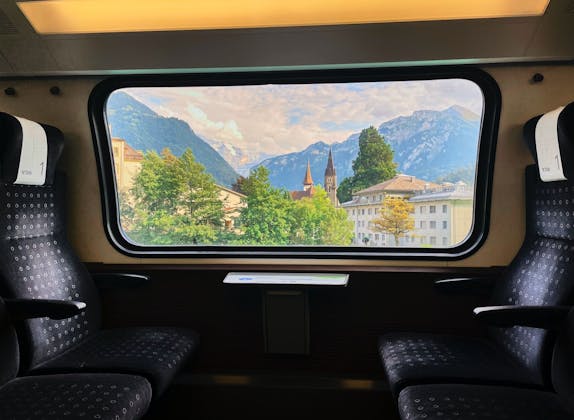
Saver Day Pass SBB - starting at 29 CHF
Validity: All day
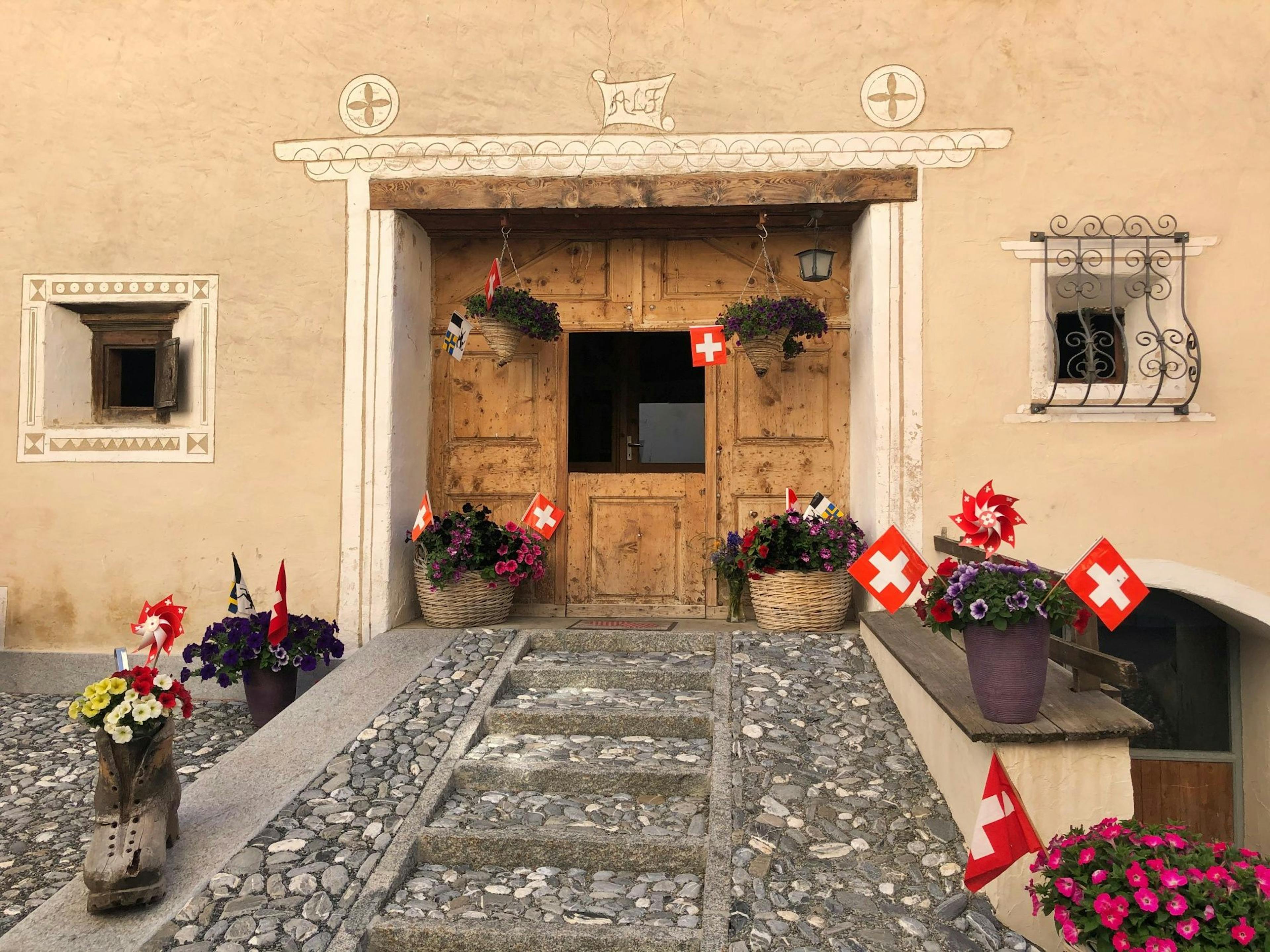
With a full eight days in Switzerland, you have several options to plan your perfect itinerary. There’s plenty to see and do in a week in Switzerland. Our selection of ten itineraries will help you organise your trip. It shows you different options that are all doable in eight days starting either in Zurich or in Geneva. All of the following itineraries are also adaptable so that you can start along the way or in a different city. This way, you can make the most of your time in Switzerland.
Although Switzerland may be small, there’s more than enough to see and do for eight days. With the high diversity of landscapes, you’ll be happy you have a decent amount of time to spend in this wonderful country. If you’re planning your trip to Switzerland, the following itineraries will help you with that process.
They are all doable within eight days and have their starting point in Zurich or in Geneva. However, if you’d like to start in a different place, you can easily adapt your trip accordingly. Zurich is very well connected and can be reached from every other city in Switzerland. So is Geneva if you like to start in a city in western Switzerland.
You will notice that we only talk about travelling by public transport and not by car. Most itineraries are also possible by car, in case you decide to get a rental during your stay in Switzerland. But with our very dense network of trains and buses, there’s no real need to travel by car.
Of course, the choice is all yours. But if you do travel by train, we recommend buying a travel pass of some sorts. Since you’ll be covering quite some ground with public transport, an Interrail, Eurail or a Swiss Travel Pass will make getting around a lot easier.
Also, if you have more than eight days available and see a Switzerland itinerary you like, you can easily stretch it out by spending an extra night in some of the places.
Happy planning!
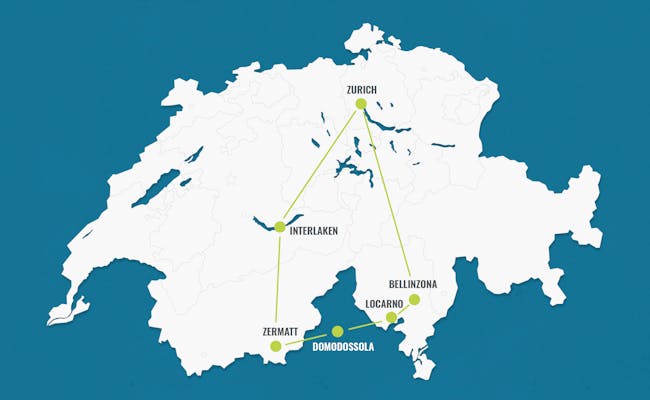 Reiseroute 1: Zürich - Locarno - Zermatt - Interlaken
Reiseroute 1: Zürich - Locarno - Zermatt - InterlakenHighlights on this itinerary:
In the morning, explore Zurich on your own, borrow a free bike with «Züri rollt» or join a guided city tour. After the tour, grab some take-away lunch and have it on the train to Bellinzona.
Thanks to the 57 kilometres (35 miles) long Gotthard-Basistunnel, it now takes you less than two hours to bolt through the Alps and reach Switzerland’s warm south. Stop over in Bellinzona and visit the Castello di Montebello, a UNESCO World Heritage site, before travelling on to Locarno.
Spend the rest of the evening taking in the Italian atmosphere in Locarno. Hang out at Piazza Grande, stroll along Lago Maggiore or just enjoy a few scoops of ice cream by the lake. And just in case you’re wondering: Yes, you’re still in Switzerland. Even if it doesn’t feel like it. This is as Italian as our country gets...
Since you’re staying in the Canton of Ticino for the next two nights, you’re entitled to a Ticino Ticket. You’ll receive it when you check in to your accommodation. This fantastic travel pass lets you use public transport for free all across the Canton of Ticino. It also gives you numerous discounts on other local attractions and activities.
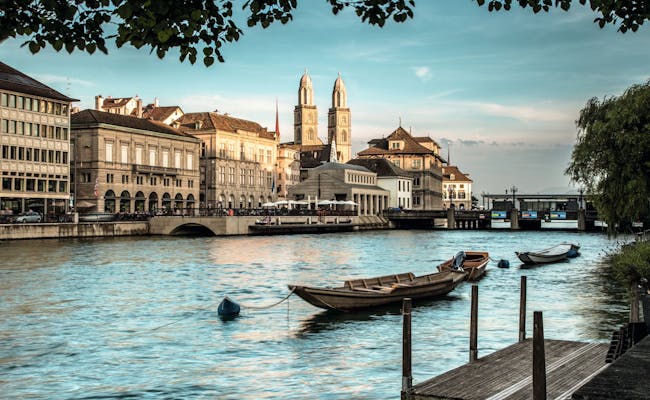 Boote auf der Limmat in Zürich (Foto: Schweiz Tourismus Jan Geerk)
Boote auf der Limmat in Zürich (Foto: Schweiz Tourismus Jan Geerk)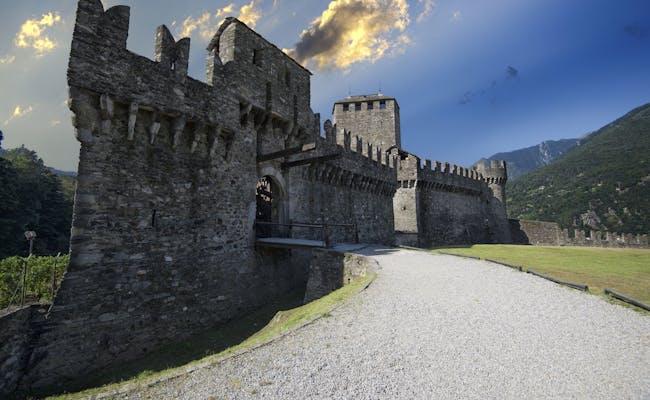 Castello Montebello in Bellinzona (Foto: Bellinzona e Alto Ticino Turismo Silvano Crivelli)
Castello Montebello in Bellinzona (Foto: Bellinzona e Alto Ticino Turismo Silvano Crivelli)Get ready to explore the Italian part of Switzerland in all its glory. With the abundance of activities to choose from, you won’t get bored today. First up, we recommend you head to one of the two river valleys: Maggia or Verzasca. Both are fantastic for hiking, spending some time by the river or going for a refreshing swim.
Also, don’t forget to bring your picnic on this journey. You’ll find countless opportunities to take a break in both valleys. One of our favourite places is right below the famous stone bridge in Lavertezzo.
If you prefer calmer waters over cold mountain streams, head to Lago Maggiore or Lago di Lugano. Both lakes are stunning and provide you with more photo opportunities than you can imagine.
Other popular destinations in Ticino are the inspiring little artsy town of Ascona next to Locarno and the city of Lugano further south.
To brush up on your Swiss geography knowledge, visit Swissminiatur in Melide just outside Lugano. It’s a miniature version of Switzerland and displays incredible attention to detail.
In case you’re one of those adrenaline junkies, there’s always the 007 bungy at the end of Verzasca valley. You might have seen this 220 metre (720 feet) dive in the James Bond movie Golden Eye. If you decide to throw yourself off that wall, please don’t forget to share your picture with us. We’d love to see that...🙂
As you might have gathered by now, this day is by no means long enough to do everything on the list.
Good thing there’s always tomorrow.
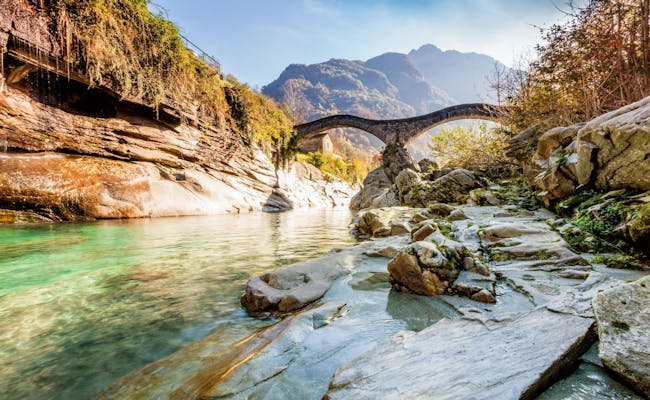 Brücke bei Lavertezzo (Foto: Ascona Locarno Tourism Alessio Pizzicannella)
Brücke bei Lavertezzo (Foto: Ascona Locarno Tourism Alessio Pizzicannella)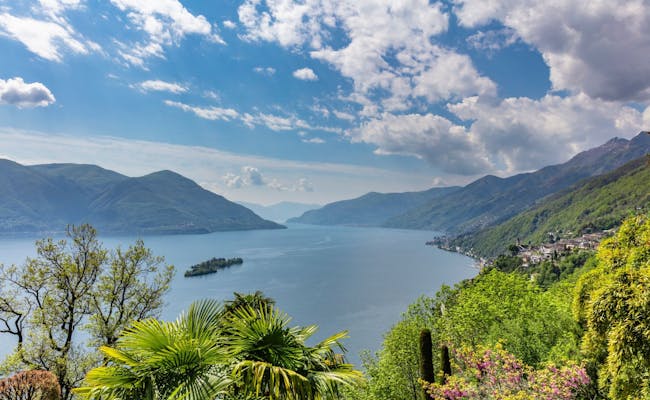 Aussicht auf den Lago Maggiore (Foto: Ascona-Locarno Tourismo Alessio Pizzicannella)
Aussicht auf den Lago Maggiore (Foto: Ascona-Locarno Tourismo Alessio Pizzicannella)Knock yourself out doing whatever you missed out on yesterday. The list should be long enough to keep you busy for another day. Alternatively, leave Switzerland and hop across the border to Italy.
Not far from Lugano lies the idyllic Como region, the place where George Clooney and other celebrities got married. If you’re curious to find out what Mr. Nespresso saw in this part of the world, today’s your chance.
The two main places we recommend visiting in the area are the city of Como and the village of Menaggio. Both are situated by the shores of Lake Como and will automatically make you take a step back and enjoy the laid-back atmosphere.
At the end of the day, head back to Switzerland and spend whatever time you have left in Locarno before moving on to Zermatt tomorrow.
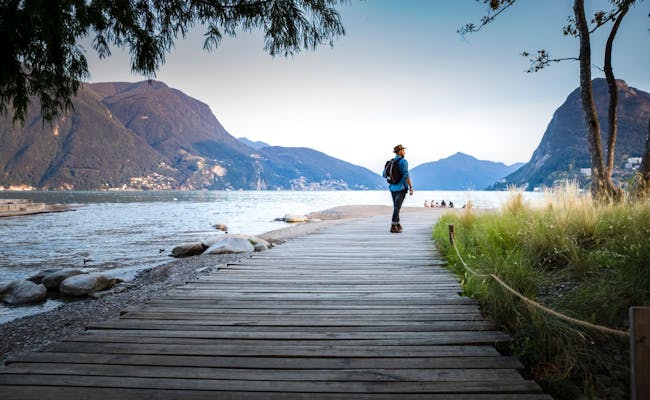 Foce del Cassarate in Lugano (Foto: Ticino Turismo Loreta Daulte)
Foce del Cassarate in Lugano (Foto: Ticino Turismo Loreta Daulte)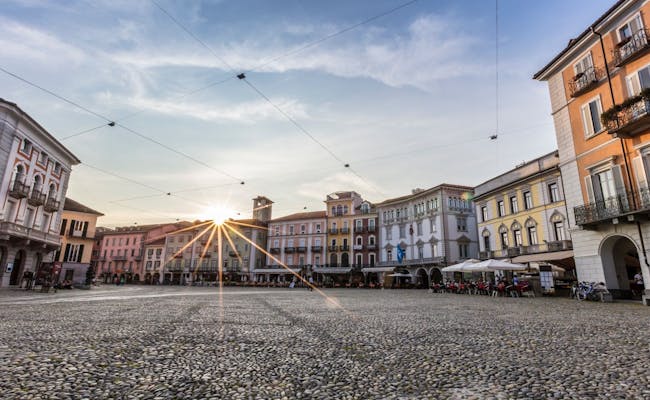 Piazza Grande in Locarno (Foto: Ascona Locarno Tourism Alessio Pizzicannella)
Piazza Grande in Locarno (Foto: Ascona Locarno Tourism Alessio Pizzicannella)You’re probably going to laugh now. But the station your train to Domodossola leaves from is called Locarno FART. Unfortunate name, we know. It’s short for Ferrovie Autolinee Regionali Ticinesi and translates to “regional railway of Ticino”.
The ride to Domodossola lasts just under two hours. It might be the slowest train you’ve ever been on but chances are you won’t even notice time passing by.
The landscape is beyond stunning from start to finish. As you travel through the impressive Centovalli region – which stands for one hundred valleys – you’ll pass several charming villages with old stone houses, ride across tall viaducts and even catch a glimpse of a waterfall or two.
Enjoy the views because from Domodossola to Brig, you’ll be spending most of the time in a tunnel. That’s ok though because the ride from Brig to Zermatt is part of the Glacier Express – another scenic train ride.
Once you arrive in Zermatt, spend the rest of the day strolling through this little town and enjoy the sight of the mighty Matterhorn. Provided it’s not veiled in clouds.
 Bergdorf Zermatt im Herbst (Foto: Zermatt Tourismus Pascal Gertschen)
Bergdorf Zermatt im Herbst (Foto: Zermatt Tourismus Pascal Gertschen)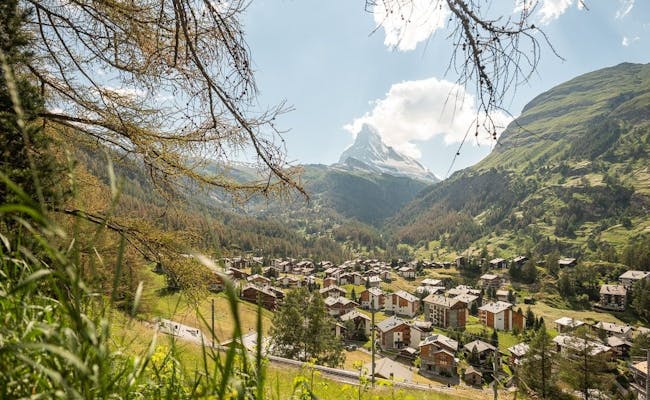 Bergdorf Zermatt mit Matterhorn (Foto: Pascal Gertschen)
Bergdorf Zermatt mit Matterhorn (Foto: Pascal Gertschen)Zermatt is all about mountains and the outdoors. If you’ve come to Switzerland for our spectacular mountain views, you’re going to love it here.
Several hikes and walks of all difficulty levels take you places you didn’t even know existed. Like for instance the popular Zermatt five-lakes trail, which takes 2.5 hours to complete. It leads past five crystal clear mountain lakes with breathtaking views of the Matterhorn.
Another impressive, yet head spinning adventure, is walking across the world’s longest pedestrian suspension bridge in Randa. It stretches 494 metres (1.620 feet) across the valley.
Hello vertigo!
The circular track starts and finishes in Randa, 15 minutes by train from Zermatt.
In case you’d rather skip the hiking altogether and see some mountains the easy way, we recommend heading up to Gornergrat. After a ridiculously steep train ride, you’ll find yourself at an altitude of 3089 metres (10.135 feet) above sea level. Right in front of the Gorner Glacier and the Matterhorn.
Don’t be surprised if climbing those steps to the viewpoint leaves you completely breathless. It’s not you, it’s the thin air.
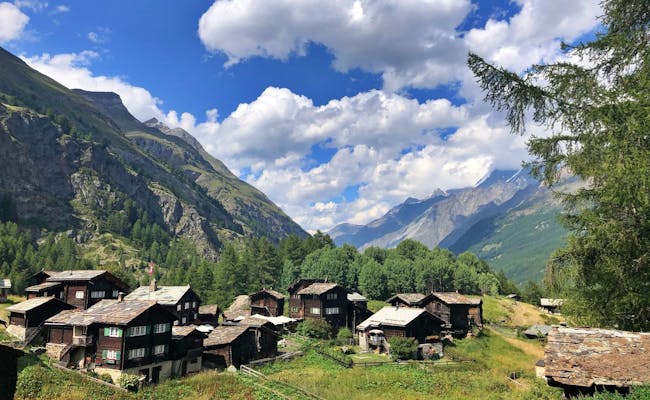 Bergdorf in Zermatt mit Bergpanorama (Foto: Seraina Zellweger)
Bergdorf in Zermatt mit Bergpanorama (Foto: Seraina Zellweger)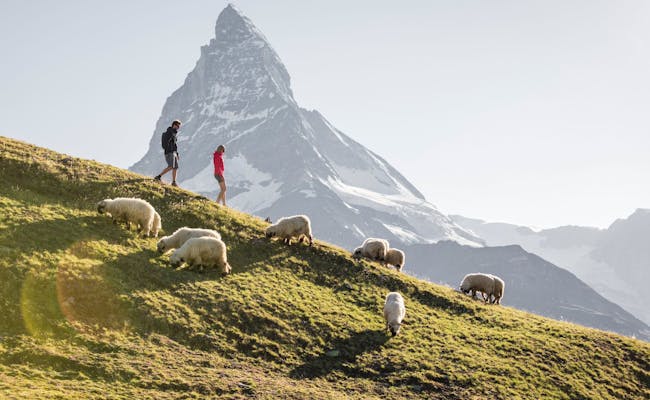 Wandern am Riffelberg mit Matterhorn Blick (Foto: Zermatt Tourismus Pascal Gertschen)
Wandern am Riffelberg mit Matterhorn Blick (Foto: Zermatt Tourismus Pascal Gertschen)How you plan out today is entirely up to you. One option is to stay in Zermatt for a little while longer and keep hiking, looking for marmots, skiing, snowshoeing, taking photos of glaciers or whatever else you’ve set your mind to.
Alternatively, if you’ve had enough of the thin air and are ready to head back down, travel onward to the adrenaline packed and popular town of Interlaken. Spend the rest of the day in this conveniently located place between two crystal clear lakes. Activities are endless and you’ve got all day tomorrow to explore Interlaken and its surroundings.
Since your options in this area are so plentiful, check tomorrow’s suggestions to see if you can find something to tick off the list this afternoon already. Maybe you fancy a short trip to Lauterbrunnen or a ride up Harder Kulm for some great views?
 Brücke in Interlaken (Foto: Seraina Zellweger)
Brücke in Interlaken (Foto: Seraina Zellweger)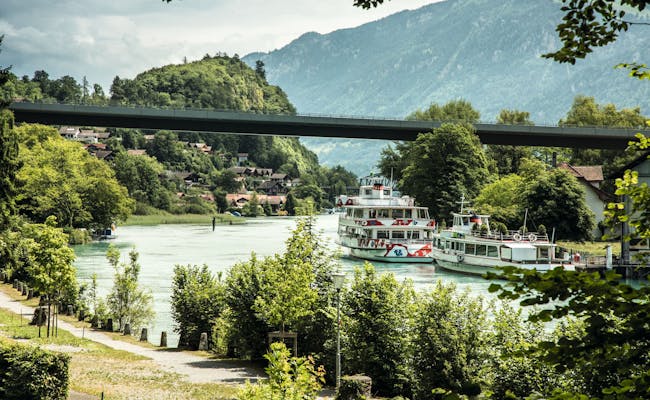 Fähren Fahrt in Interlaken (Foto: Schweiz Tourismus)
Fähren Fahrt in Interlaken (Foto: Schweiz Tourismus)You’ve got more activities to choose from today than you can wrap your head around. It all depends on your budget, but in an adrenaline-packed place like Interlaken, the sky’s the limit.
If even that...
Skydiving, paragliding, canyoning and jet boating are all popular activities that will get your adrenaline flowing.
Another option is to embark on a passenger ship cruise on either Lake Thun or Lake Brienz. Both rides come with incredible views that will make you wish you’d never have to leave.
If you’re looking for a stopover on one of the cruises, get off at either Giessbach (Lake Brienz), the Saint Beatus Caves or Spiez (Lake Thun).
The Jungfrau region around Interlaken is also an excellent playground for hikers. The amount of trails is nearly endless and whatever your fitness level and ambitions, you’ll find something to your taste.
Of course, the No. 1 destination everybody wants to see out here is the famous Jungfraujoch – aka Top of Europe. If you’re after a slightly more budget-friendly experience, we suggest looking into visiting Mount Schilthorn, Schynige Platte, Grindelwald First or Männlichen instead. The rides up to these mountains and the views from the top won’t disappoint you.
Other places of interest in and around Interlaken are: the open-air museum Ballenberg, the chocolate workshops at Funky Chocolate Club, the two mountain lakes Blausee or Oeschinensee or the Aare Gorge.
And let’s not forget those charming towns and villages like Brienz, Spiez, Thun, Lauterbrunnen or Grindelwald.
We could go on forever here but we guess this would only make you hate that you don’t have all week here.
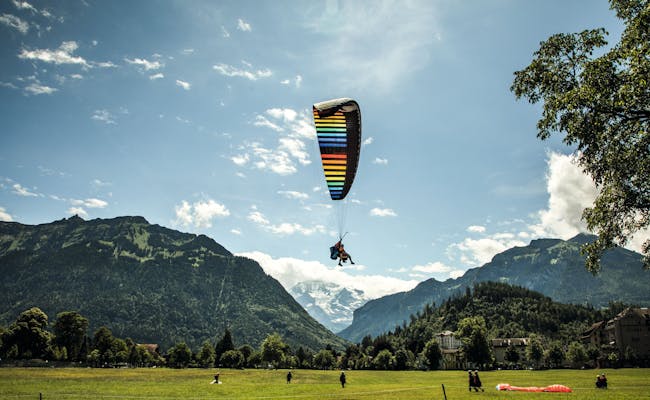 Gleitschirm Landung bei Interlaken (Foto: Schweiz Tourismus)
Gleitschirm Landung bei Interlaken (Foto: Schweiz Tourismus)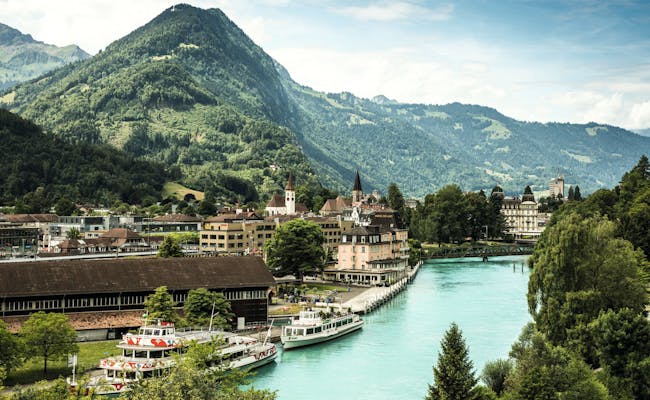 Panorama von Interlaken (Foto: Schweiz Tourismus)
Panorama von Interlaken (Foto: Schweiz Tourismus)You probably didn’t get to do everything you set your mind to these past two days. This is why you have another day to knock yourself out in and around Interlaken today. Do what you need to do before heading back to Geneva in the late afternoon or evening. The train ride from Interlaken to Geneva takes roughly three hours and unless you have a plane to catch, there’s no rush to get back.
Or, if you’re leaving Switzerland from Zurich, head that way instead. The fastest connection leads through Bern and takes two hours. However, if you have time and fancy completing the Golden Pass Line, you have the option to travel to Zurich through Lucerne instead. This will take you an extra hour but is way more scenic than the journey through Bern.
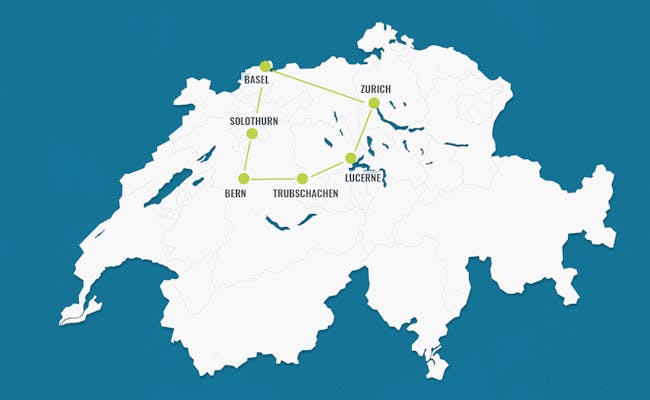 Reiseroute 2: Zürich - Luzern - Bern - Basel
Reiseroute 2: Zürich - Luzern - Bern - BaselHighlights on this itinerary:
Leave Zurich first thing in the morning and catch the train to Lucerne. Store your luggage either at the train station or at your accommodation and take the next train to Arth Goldau. From here, the Rigibahn – a cog railway that’s been around for over 150 years – takes you on a 45-minute ride to the top station Rigi Kulm.
Provided Mount Rigi isn’t veiled in clouds, you’ll be presented with spectacular views over the Alps, Lake Lucerne and other surrounding lakes. Just follow the signs to the viewing point after getting off at Rigi Kulm.
Once you’ve snapped enough photos, either take a break at the restaurant, catch the train down to Vitznau or go for a hike. With over 120 kilometres (75 miles) of hiking trails at your feet, you’re spoiled for choice here.
Upon arrival in Vitznau, the passenger ship to Lucerne will be waiting for you. Keep your camera within reach because this scenic and peaceful ride offers some more stunning views.
Back in Lucerne, spend the rest of the evening exploring the city or find a cosy spot by the lake to relax.
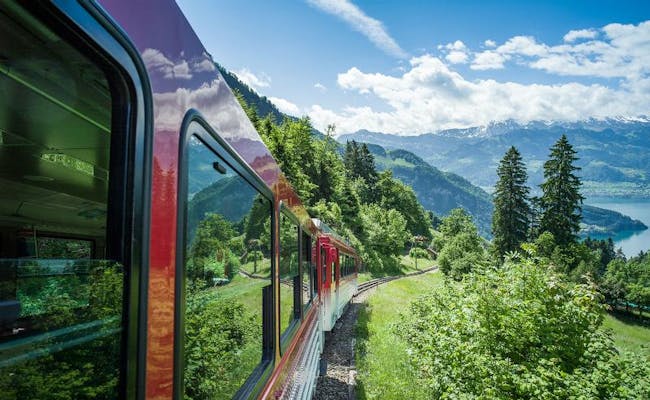 Fahrt mit der Rigi Bahn (Foto: Rigi Bahnen Gaudenz Danuser)
Fahrt mit der Rigi Bahn (Foto: Rigi Bahnen Gaudenz Danuser) Schifffahrt auf dem Vierwaldstättersee (Foto: Schweiz Tourismus Beat Müller)
Schifffahrt auf dem Vierwaldstättersee (Foto: Schweiz Tourismus Beat Müller)Lucerne has an abundance of activities to offer. One of the most obvious picks is to catch the world’s steepest cog railway to Mount Pilatus, Lucerne’s backyard mountain. This railway only leaves from Alpnachstad during summer, while the cable car from Kriens takes you up to Mount Pilatus all year round.
Speaking of mountains: Mount Titlis is another landmark in the area worth visiting. From Engelberg, you’ll reach the top by catching two gondolas. One of them is the world’s first revolving aerial cableway. So expect some impressive 360-degree views at the top.
For an easy hike, including a ride on a 152.8 metres-high rocket-like outdoor elevator, catch the passenger ship or the bus to Kehrsiten-Bürgenstock.
And let’s not forget Stanserhorn, a mountain close to Lucerne that is accessed by a fancy double-deck cable car. The best way to take this trip is by catching the passenger ship to Stansstad. From there, catch the funicular railway for the first leg and get on the open-air gondola for the final part to Stanserhorn.
Technically, you could even visit Interlaken for the day. Leave Lucerne on the Golden Pass Line in the morning, spend the day exploring the photogenic region around Interlaken and head back to Lucerne in the evening.
Another great way to spend the day around Lucerne is on Lake Lucerne. Several steamboats and passenger ships operate on the Lake and take you on the most stunning journeys.
As you can see, Lucerne has plenty to offer on a sunny day. But in reality, the weather isn’t always too promising. In this case, here are some cool indoor options for you.
For one, there’s Aeschbach’s Chocoworld in Root. Getting there by bus takes around 30 minutes. Nothing brightens up a rainy day like some delicious chocolate, does it?
In Hergiswil, not far from Lucerne, you’ll find what the Swiss affectionately call the Glasi. Hergiswil Glassworks runs you through the process of glass-making, lets you watch the pros in action and even offers the opportunity to give glassblowing a shot. When’s the last time you made your own glass?
Another bad-weather option is the Museum of Transport. As the name suggests, this museum covers every means of transport throughout history. From bicycles to astronautics, they’ve got it all.
 Berühmte Kapellbrücke in Luzern (Foto: Luzern Tourismus)
Berühmte Kapellbrücke in Luzern (Foto: Luzern Tourismus) Blick von der Kapellbrücke (Foto: Luzern Tourismus)
Blick von der Kapellbrücke (Foto: Luzern Tourismus)Luckily, you don’t have to leave Lucerne until lunchtime today. So spend the morning doing whatever you didn’t get to do yesterday. Whatever you do, make sure you work up an appetite and don’t grab too big a lunch for your ride to Trubschachen. You’ll need every free inch in your stomach for the biscuit-feast awaiting you.
Once you’re ready to move on, catch the train to Trubschachen. But watch out. This train gets split up along the way and only the front part travels through the picturesque Entlebuch region to the Kambly factory. When you’re at the platform in Lucerne, please check the display to make sure you get on the right half of the train.
The Kambly factory store right next to Trubschachen station is free to visit. In here, you can spend as much time as you like tasting up to 100 types of delicious biscuits. Unfortunately, you can’t visit the factory and watch the production of this iconic Swiss biscuit. However, they do have a cinema at the shop where they give you some more insight into this traditional family business.
After reaching the point of explosion, or maybe two biscuits before, move on to Bern. To digest your Kambly overdose, go for a walk in Switzerland’s capital city. For an impressive night view over Bern, we recommend heading up to Rosengarten.
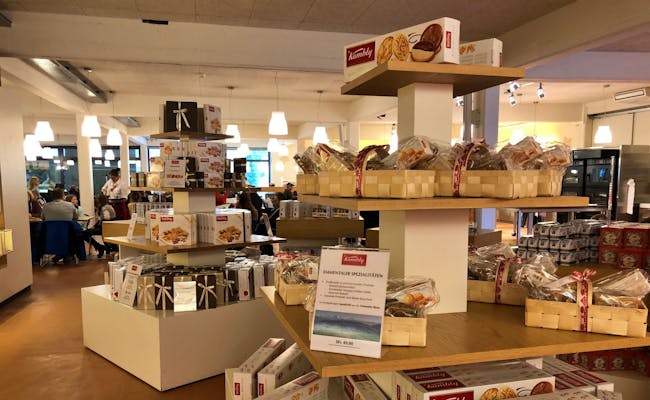 Fabrikladen von Kambly (Foto: Seraina Zellweger)
Fabrikladen von Kambly (Foto: Seraina Zellweger)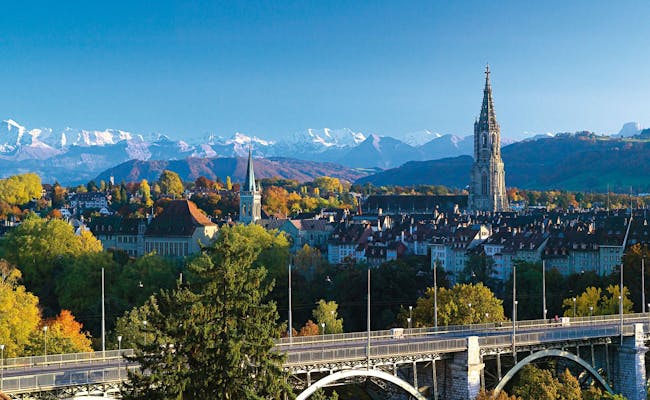 Blick auf die Hauptstadt der Schweiz (Foto: Bern Welcome)
Blick auf die Hauptstadt der Schweiz (Foto: Bern Welcome)In this beautiful UNESCO listed town, you’ve got plenty of activities to choose from. Join a guided city tour or explore Bern on your own. Take a stroll through the old town, head to the bear park, check out the Bundeshaus (House of Parliament) and walk back up to Rosengarten for more views.
You can also visit Gurten – Bern’s backyard mountain – see some animals at Dählhölzli wildlife park or visit the botanical garden. Alternatively, catch the elevator at the train station to hang out at Grosse Schanze or go for a swim either in the River Aare or at Weyermannshaus.
Bern is also conveniently located in close proximity to a variety of breathtaking destinations. So you can easily go on a daytrip from here. For one, there’s Thun and Interlaken, which are two wonderful places to visit for some spectacular lake and mountain views.
If you’re into mountain lakes, you’re in luck, too. Lake Oeschinensee and Blausee are both within reach from Bern and more than worth a trip. The crystal clear water in both lakes will leave you breathless.
Only half an hour west of Bern lies the mediaeval city of Fribourg. If you decide to head over there, follow the citywalk signs leading you through this mighty old town. The signs will lead you up and down some very steep alleyways, across ancient wooden bridges, down to the River Saane and past the city’s very own funicular. For an even better view of your surroundings, tackle the 365 steps to the tower of the Cathedral. The River Saane at the bottom of the city is a great spot to stretch your legs and treat yourself to a snack.
Technically, you could take this even further and head to Gruyères and Broc for some typical Swiss cheese and chocolate. Whatever you end up doing today and whenever you’re ready, head back to Bern for your last night in the city.
You should definitely find enough things to keep you busy for a day.
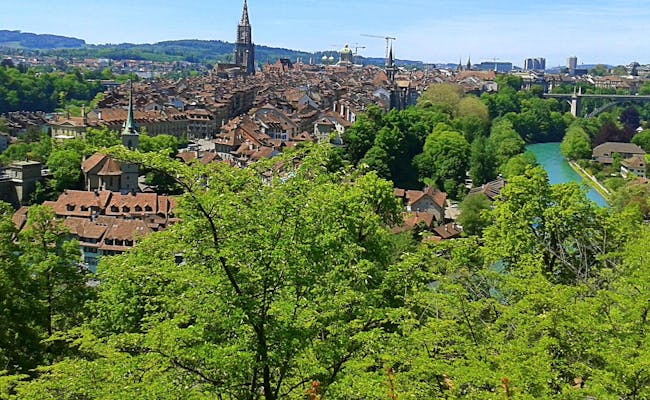 Aussicht vom Rosengarten in Bern (Foto: Seraina Zellweger)
Aussicht vom Rosengarten in Bern (Foto: Seraina Zellweger)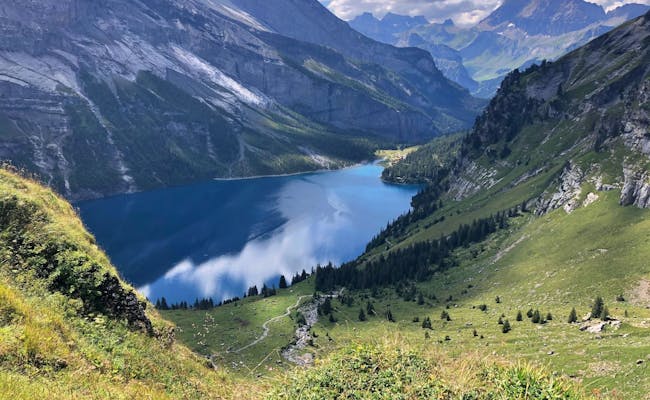 Bergpanorama beim Oeschinensee (Foto: Seraina Zellweger)
Bergpanorama beim Oeschinensee (Foto: Seraina Zellweger)If there’s anything you wanted to do in Bern yesterday but ran out of time, get that over with in the morning and leave for Solothurn whenever you’re ready.
Solothurn is commonly known as “Switzerland’s most beautiful baroque city”. Take a stroll through this pretty old town and get ready to spend a full day in the area tomorrow. Also, go ahead and treat yourself to a few scoops of ice cream at Vitaminstation – one of the ice cream places ever – and have it while sitting on the stone wall along the River Aare.
You’ll fit right in with the locals in doing so.
Seraina’s Tip: My two absolute favourite places for food in Solothurn are Pittaria and Vitaminstation. Anyone that likes a good falafel or hummus is going to love Pittaria. And Vitaminstation makes some of the best ice cream I’ve ever tasted in Switzerland.
Although Solothurn is by no means a big city, there’s still plenty to see and do in the area. One activity we particularly recommend is going on a hike in the Jura mountains. This high plateau is a wonderful area to visit all year round.
One option to reach the top with its countless walking trails is by cable car from Oberdorf to Weissenstein. Feel free to walk as long and as far as you like before hiking back down or catching the cable car to Oberdorf.
A very popular hike is the round trip from Solothurn via Balmberg and Weissenstein. Catch the Postauto in Solothurn, get off at Balmberg, walk along the crest to Weissenstein and head back down to Oberdorf by cable car. From Oberdorf, the train will take you back to Solothurn.
This is an easy walk and takes you into the Jura without too much effort. During your hike, you’ll also enjoy the view over the Alps, including Eiger, Mönch and Jungfrau.
Another place you can visit is Verena Gorge. You can walk along the creek through the forest in the gorge until you reach the little hermitage at the end. The walk takes roughly 45 minutes return and is super peaceful.
Alternatively, hop on the passenger ship to Biel. How long you stay on it really depends on your preferences. You can go all the way to Biel – which takes around three hours – or get off anywhere along the way and catch the train back to Solothurn.
One of the highlights on this tour will be Switzerland’s largest stork station in Altreu, which you’ll pass about 45 minutes into the journey. In 1950, when storks were nearly extinct in Switzerland, Max Bloesch started his reintroduction project to save our storks. Thanks to him, around 40 breeding pairs can be seen soaring through the air, strutting across the fields and clattering on the rooftops around Altreu these days.
Only in spring and summer, though. They travel to warmer territories in autumn until winter is over.
If you continue your journey onward to Biel, the views of the Jura mountains and the Swiss Central Plateau will accompany you all the way. After passing through a watergate, you’ll arrive at the port in Biel, which is only a short walk from the train station.
From there, heading back to Solothurn will take 15 minutes by train.
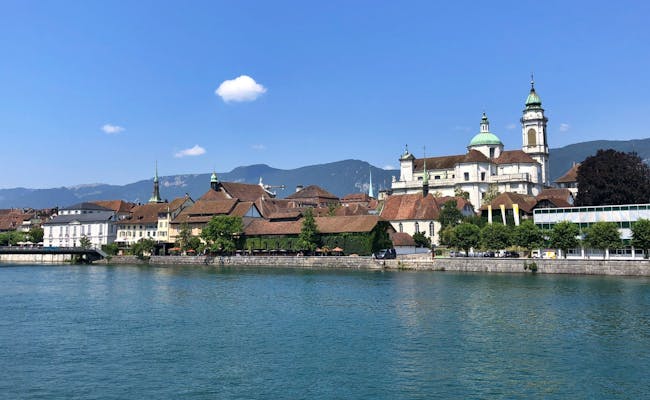 Kirche am Fluss in Solothurn (Foto: Seraina Zellweger)
Kirche am Fluss in Solothurn (Foto: Seraina Zellweger)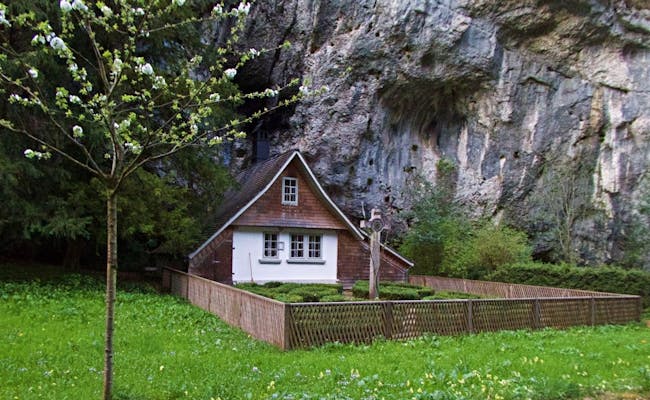 Idyllische Hütte in der Verenaschlucht (Foto: Seraina Zellweger)
Idyllische Hütte in der Verenaschlucht (Foto: Seraina Zellweger)If you’d like to cover some more ground in Solothurn this morning, stick around as long as you need to before moving on to Basel. The train ride takes just under an hour. Basel is a vibrant city right on the German and French border. It offers several walking tours at various times throughout the week. Pick a tour or just head out into the city on your own.
Stop by the Pfalz – the perfect viewing platform to snap some postcard-quality photos – walk along the River Rhine to watch the big cargo ships enter and leave the harbour, pass by the Cathedral or geek out in one of the many museums.
During the warmer summer months, an activity you might enjoy is joining the locals for a swim in the River Rhine. Before hopping into the water and letting the current take them downstream, they usually pack their clothes into a so-called Wickelfisch. This dry-bag comes in the shape of a fish and is iconic to Basel.
 Münsterplatz in Basel (Foto: Basel Tourismus)
Münsterplatz in Basel (Foto: Basel Tourismus) Brücke über den Rhein in Basel (Foto: Schweiz Tourismus Jan Geerk)
Brücke über den Rhein in Basel (Foto: Schweiz Tourismus Jan Geerk)If there’s something you didn’t get to do in Basel yesterday, today’s your day. But in case you’ve seen enough of the city already, you can always hop across the border and visit Weil am Rhein in Germany or St. Louis in France.
Technically, you could even visit three countries in one day. Switzerland, Germany and France. That’s completely doable in Basel and might be something you don’t get to experience every day. Especially if you’re from a country that requires you to get on a plane to cross the nearest border within a reasonable amount of time.
Whenever you’re ready to leave Basel, head back to Zurich and spend the rest of the day exploring Switzerland’s largest city. Since you didn’t have any time to hang out here, you might like to do some sightseeing.
If time allows, visit the Lindt chocolate factory to end this itinerary. Right next to Zurich, in Kilchberg, you’ll find the brand new Lindt visitors’ centre, which opened their doors in September 2020 to the public. If you’ve never tried a roasted cocoa bean before, eaten as many Lindor balls as you can or enjoyed some quality time with the world’s tallest chocolate fountain, this is your chance.
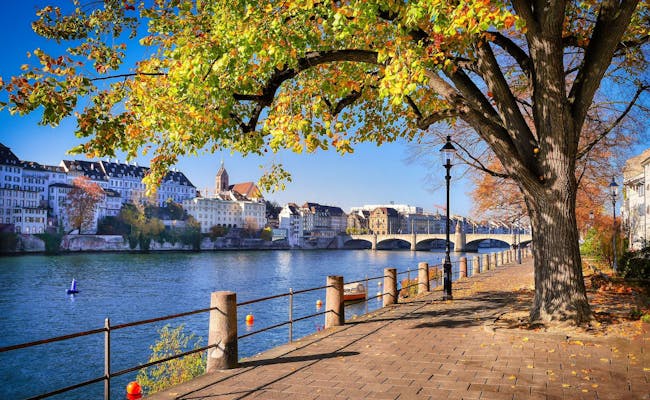 Rhein Ufer in Basel (Foto: Pixabay)
Rhein Ufer in Basel (Foto: Pixabay) Altstadt von Zürich an der Limmat (Foto: Seraina Zellweger)
Altstadt von Zürich an der Limmat (Foto: Seraina Zellweger)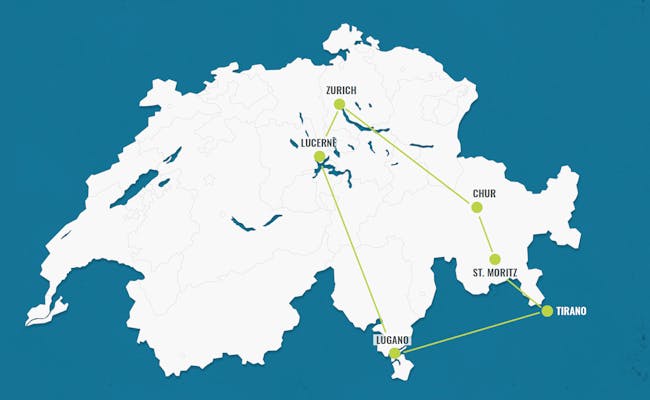 Reiseroute 3: Zürich - Chur - Lugano - Luzern
Reiseroute 3: Zürich - Chur - Lugano - LuzernHighlights on this itinerary:
In the morning, explore Zurich on your own, borrow a free bike with «Züri rollt» or join a guided city tour. After the tour, grab some take-away lunch and have it on the train to Chur.
For better views of Lake Zurich and Lake Walensee on your way to Chur, we recommend grabbing a seat on the left when you get on the train. Spend an hour or two strolling through Chur – the capital of the Grisons – and get ready for the clean alpine air awaiting you in St. Moritz.
To get to St. Moritz, catch the train in Chur. Make sure you have your camera ready because you’ll be spoiled with panoramic views from start to finish. The Landwasser Viaduct and the curvy Albula Line are two highlights on this leg.
Spend the rest of the day hanging out in St. Moritz. If you find yourself feeling unusually sleepy tonight, thank the high altitude of 1822 metres (5977 feet) above sea level for that. It usually takes people a day or two to get accustomed to the thin air.
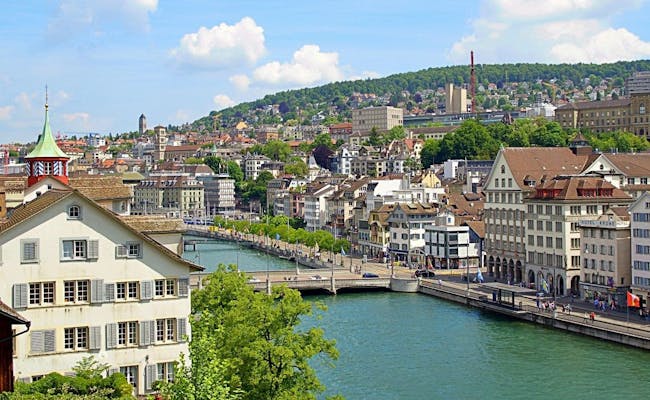 Lindenhof in Zürich an der Limmat (Foto: Seraina Zellweger)
Lindenhof in Zürich an der Limmat (Foto: Seraina Zellweger)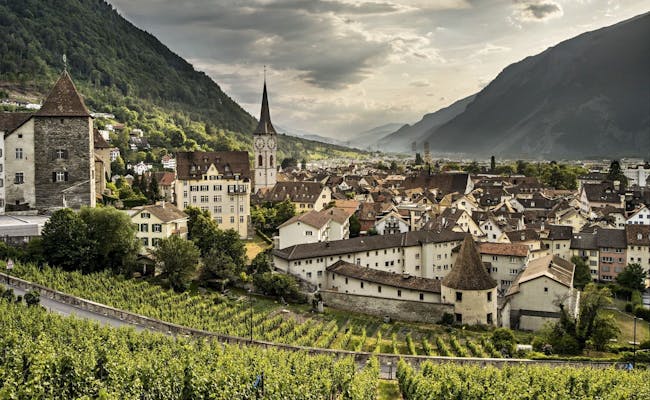 Bergpanorama von Chur (Foto: Schweiz Tourismus Markus Buehler-Rasom)
Bergpanorama von Chur (Foto: Schweiz Tourismus Markus Buehler-Rasom)St. Moritz is all about the outdoors. Summer and winter. Whether you’re into biking, hiking, stand up paddling, swimming, windsurfing, skiing, snowboarding, snowshoeing, cross-country skiing or just going for a walk, you’ll find your fix.
Only a short ride from St. Moritz lies Lake Silvaplana, a stunning place to cover some of those activities.
Another place worth visiting, since you have a full day in St. Moritz, is Ospizio Bernina. With 2253 metres (7397 feet) above sea level, this little railway station is the highest spot of the Bernina Express Line. Trains from St. Moritz leave every hour and lead you past several good-looking spots with lakes, glaciers and towering mountains.
On the culinary side, we recommend two things in the Grisons. Firstly, don’t miss out on a bowl of Bündner Gerstensuppe. This barley soup with vegetables and meat is iconic to the Grisons. It warms you up like nothing else on a chilly day.
Secondly, treat yourself to a slice of Engadiner Nusstorte. This heavy, delicious pastry puts the calories right back where you’ve been trying to lose them. But it’s so worth it.
Back in St. Moritz, spend the rest of the day strolling through the town. It’s not as charming and mystical as other villages in the area like Samedan or La Punt. But it’s great for window shopping and maybe, if you’re lucky, you’ll even spot a celebrity or two.
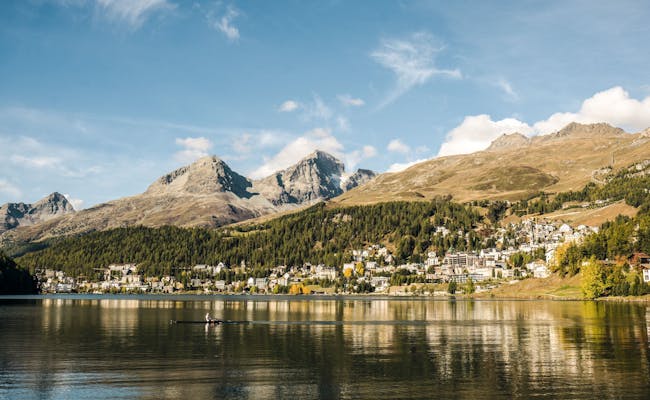 Kanufahren bei St. Moritz (Foto: Schweiz Tourismus Markus Aebischer)
Kanufahren bei St. Moritz (Foto: Schweiz Tourismus Markus Aebischer) Wandern bei Corvatsch (Foto: Engadin St. Moritz Tourismus Christof Sonderegger)
Wandern bei Corvatsch (Foto: Engadin St. Moritz Tourismus Christof Sonderegger)Today, you’ll be spending quite a few hours travelling across the Alps from St. Moritz all the way to Lugano. Your journey will take you up to the highest point of the Bernina Express Line, past glistening glaciers and crystal clear mountain lakes, down to the southern part of Switzerland and across a spectacular viaduct before crossing into Italy.
And eventually back to Switzerland...
The first leg of this scenic train ride takes you to Ospizio Bernina, the highest point of today’s journey. This little railway station isn’t far from St. Moritz and lies 2253 metres (7391 feet) above sea level. It’s all downhill from here. Figuratively speaking, of course. As you make your way down toward Italy, you cross the circular viaduct in Brusio. Here, the train takes a full 360-degree turn to overcome the altitude.
At this point, you’ll have lost quite some altitude and the outside temperature will be a lot warmer than it was just a couple of hours ago. The last leg of the journey starts in Tirano, right next to the Swiss-Italian border. From Tirano, the Bernina Express Bus takes you through the impressive Valtellina wine region.
Before crossing back into Switzerland, you’ll drive past Lake Como, the place where George Clooney and many other celebrities got married.
After this long day, you might like to stretch your legs at the promenade of Lake Lugano. Enjoy the view, grab a few scoops of ice cream and take a stroll through Lugano.
You’ve earned it.
Since you’re staying in the Ticino for the next three nights, you’re entitled to a Ticino Ticket. You’ll receive it when you check in to your accommodation. This fantastic travel pass lets you use public transport for free all across the Canton of Ticino. It also gives you numerous discounts on other local attractions and activities.
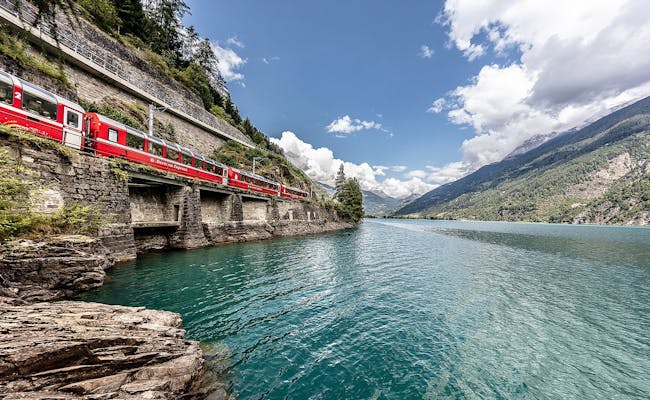 Bernina Express am Lago di Poschiavo (Foto: Swiss Travel System)
Bernina Express am Lago di Poschiavo (Foto: Swiss Travel System)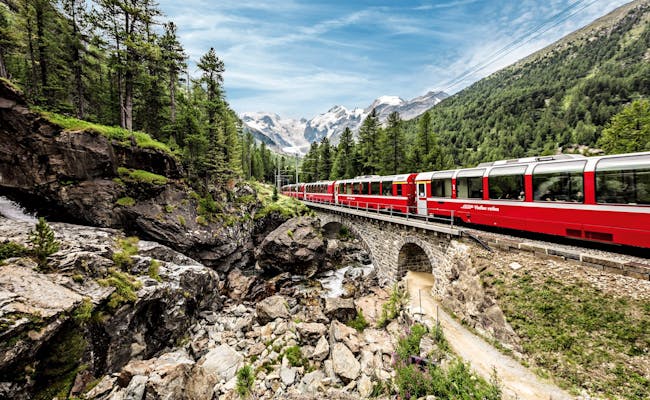 Bernina Express bei Morteratsch (Foto: Swiss Travel System)
Bernina Express bei Morteratsch (Foto: Swiss Travel System)Get ready to explore the Italian part of Switzerland in all its glory. With the abundance of activities to choose from, you won’t get bored today. First up, we recommend you head to one of the two river valleys: Maggia or Verzasca. Both are fantastic for hiking, spending some time by the river or going for a refreshing swim.
Also, don’t forget to bring your picnic on this journey. You’ll find countless opportunities to take a break in both valleys. Our favourite place is right below the famous stone bridge in Lavertezzo.
If you prefer calmer waters over cold mountain streams, head to Lago Maggiore or Lago di Lugano. Both lakes are stunning and provide you with more photo opportunities than you can imagine.
Other popular destinations in Ticino are the inspiring little artsy town of Ascona next to Locarno and the city of Lugano further south.
To brush up on your Swiss geography knowledge, visit Swissminiatur in Melide just outside Lugano. It’s a miniature version of Switzerland and displays incredible attention to detail.
In case you’re one of those adrenaline junkies, there’s always the 007 bungy at the end of Verzasca valley. You might have seen this 220 metre (720 feet) dive in the James Bond movie Golden Eye. If you decide to throw yourself off that wall, please don’t forget to share your picture with us. We’d love to see that...🙂
As you might have gathered by now, this day is by no means long enough to do everything on the list.
Good thing there’s always tomorrow.
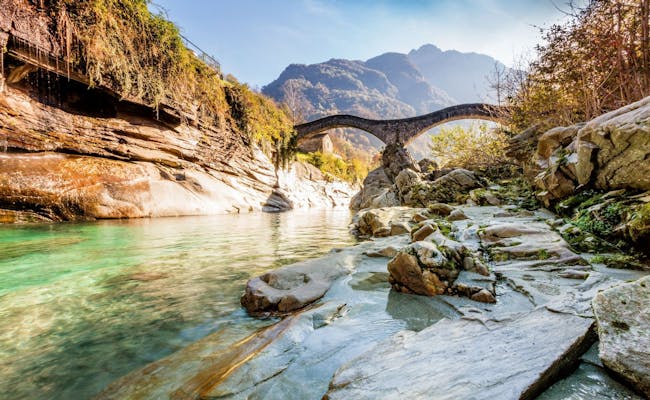 Brücke bei Lavertezzo (Foto: Ascona Locarno Tourism Alessio Pizzicannella)
Brücke bei Lavertezzo (Foto: Ascona Locarno Tourism Alessio Pizzicannella)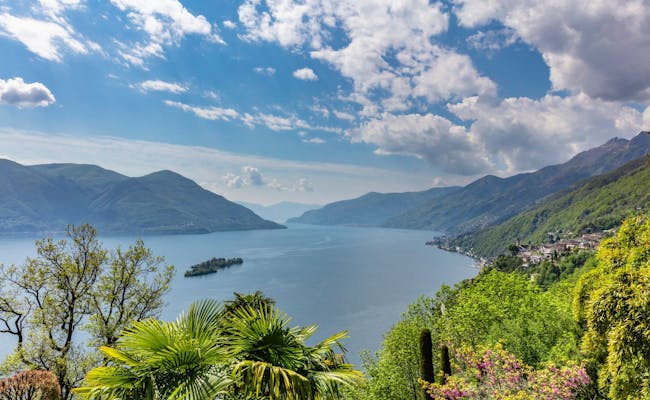 Ausblick auf den Lago Maggiore (Foto: Ascona-Locarno Tourismo Alessio Pizzicannella)
Ausblick auf den Lago Maggiore (Foto: Ascona-Locarno Tourismo Alessio Pizzicannella)Knock yourself out doing whatever you missed out on yesterday. The list should be long enough to keep you busy for another day. Alternatively, you have the option to head across the border to Italy.
Not far from Lugano lies the idyllic Como region, the place where George Clooney and other celebrities got married. If you’re curious to find out what Mr. Nespresso saw in this part of the world, today’s your chance.
The two main places we recommend visiting in the area are the city of Como and the village of Menaggio. Both are situated by the shores of Lake Como and will automatically make you take a step back and enjoy the laid-back atmosphere.
At the end of the day, head back to Switzerland and spend whatever time you have left hanging out in Lugano before moving on to Lucerne tomorrow.
If you’re visiting Switzerland between April and October, you have the opportunity to travel back across the Alps on the Gotthard Panorama Express.
On the first leg of this journey, a panoramic train will take you through the old Gotthard tunnel to Flüelen. Before Gotthard-Basistunnel opened in 2016, this was the only way to reach Ticino by rail. Nowadays, since the opening of the world’s longest tunnel, the old one is only used for tourist purposes.
From Flüelen, a steamboat will take you on a three-hour ride across Lake Lucerne. You’ll arrive in Lucerne around 3 pm, right next to the train station. This will leave you with plenty of time to explore this stunning city and its surroundings. If you can’t travel to Lucerne on the Gotthard Panorama Express, simply catch the regular train instead.
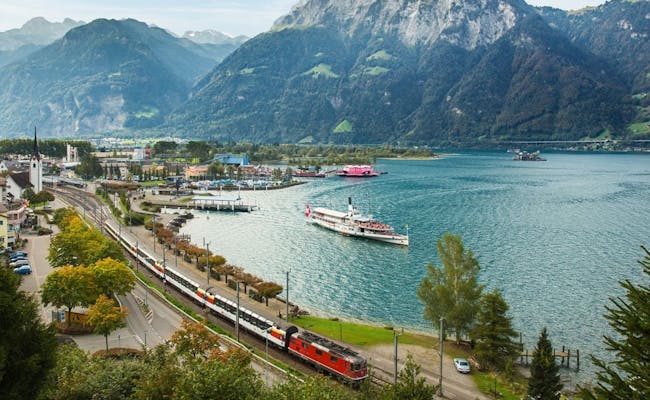 Panorama bei Gotthard (Foto: Swiss Travel System)
Panorama bei Gotthard (Foto: Swiss Travel System)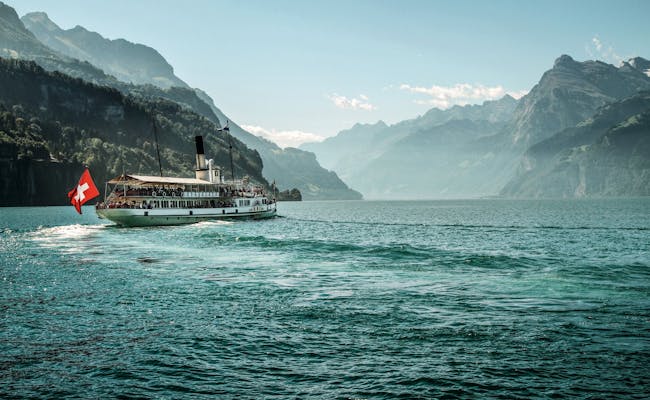 Schifffahrt auf dem Vierwaldstättersee (Foto: Schweiz Tourismus Beat Müller)
Schifffahrt auf dem Vierwaldstättersee (Foto: Schweiz Tourismus Beat Müller)Lucerne has an abundance of activities to offer. One of the most obvious picks is to catch the world’s steepest cog railway to Mount Pilatus, Lucerne’s backyard mountain. This railway only leaves from Alpnachstad during summer, while the cable car from Kriens takes you up to Mount Pilatus all year round.
Speaking of mountains: Mount Titlis is another landmark in the area worth visiting. From Engelberg, you’ll reach the top by catching two gondolas. One of them is the world’s first revolving aerial cableway. So expect some impressive 360-degree views at the top.
For an easy hike, including a ride on a 152.8 metres-high rocket-like outdoor elevator, catch the passenger ship or the bus to Kehrsiten-Bürgenstock.
And let’s not forget Stanserhorn, a mountain close to Lucerne that is accessed by a fancy double-deck cable car. The best way to take this trip is by catching the passenger ship to Stansstad. From there, catch the funicular railway for the first leg and get on the open-air gondola for the final part to Stanserhorn.
Technically, you could even visit Interlaken for the day. Leave Lucerne on the Golden Pass Line in the morning, spend the day exploring the photogenic region around Interlaken and head back to Lucerne in the evening.
Another great way to spend the day around Lucerne is on Lake Lucerne. Several steamboats and passenger ships operate on the Lake and take you on the most stunning journeys.
As you can see, Lucerne has plenty to offer on a sunny day. But in reality, the weather isn’t always too promising. In this case, here are some cool indoor options for you.
For one, there’s Aeschbach’s Chocoworld in Root. Getting there by bus takes around 30 minutes. Nothing brightens up a rainy day like some delicious chocolate, does it?
In Hergiswil, not far from Lucerne, you’ll find what the Swiss affectionately call the Glasi. Hergiswil Glassworks runs you through the process of glass-making, lets you watch the pros in action and even offers the opportunity to give glassblowing a shot. When’s the last time you made your own glass?
Another bad-weather option is the Museum of Transport. As the name suggests, this museum covers every means of transport throughout history. From bicycles to astronautics, they’ve got it all.
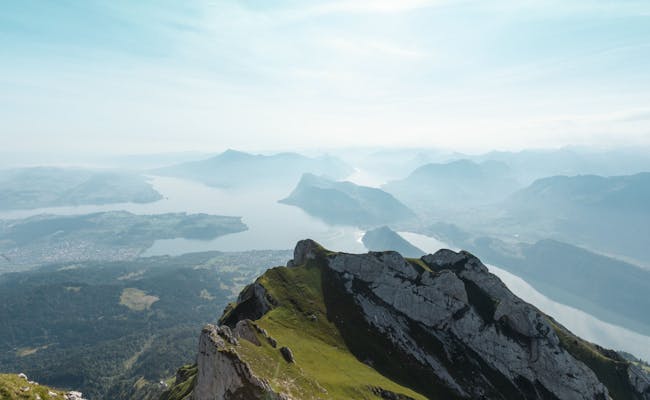 Aussicht vom Pilatus (Foto: Schweiz Tourismus Jasmin Frei)
Aussicht vom Pilatus (Foto: Schweiz Tourismus Jasmin Frei) Berühmte Kapellbrücke in Luzern (Foto: Luzern Tourismus)
Berühmte Kapellbrücke in Luzern (Foto: Luzern Tourismus)Luckily, you don’t have to leave Lucerne until the afternoon or even evening today. So spend the day doing whatever you didn’t get to do yesterday.
A popular day trip from Lucerne is heading up to Mount Rigi. To get there, store your luggage either at your accommodation in Lucerne or at the train station and take the train to Arth Goldau. From here, the Rigibahn – a cog railway that’s been around for over 150 years – takes you on a 45-minute ride to the top station Rigi Kulm.
Provided Mount Rigi isn’t veiled in clouds, you’ll be presented with spectacular views over the Alps, Lake Lucerne and other surrounding lakes. Just follow the signs to the viewing point after getting off at Rigi Kulm.
Once you’ve snapped enough photos, either take a break at the restaurant, catch the train down to Vitznau or go for a hike. With over 120 kilometres (75 miles) of hiking trails at your feet, you’re spoiled for choice here. Upon arrival in Vitznau, the passenger ship to Lucerne will be waiting for you. Keep your camera within reach because this scenic and peaceful ride offers some more stunning views.
Back in Lucerne, grab your bags and head back to Zurich.
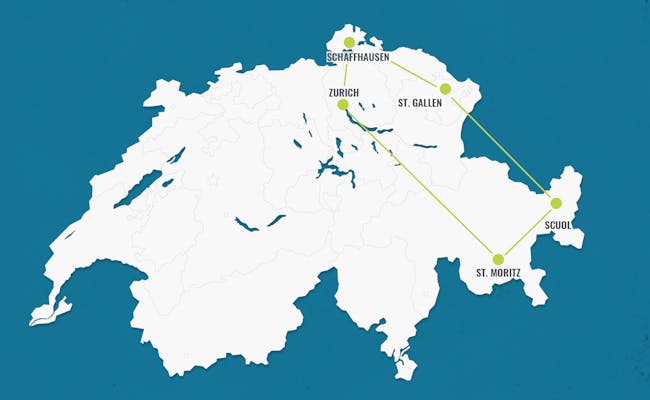 Reiseroute 4: Zürich - Schaffhausen - St. Gallen - St. Moritz
Reiseroute 4: Zürich - Schaffhausen - St. Gallen - St. MoritzHighlights on this itinerary:
In the morning, explore Zurich on your own, borrow a free bike with «Züri rollt» or join a guided city tour. After the tour, grab some take-away lunch and have it on the train to Schaffhausen.
Head straight to Neuhausen next to Schaffhausen, where the mighty Rhine Falls attract visitors from all over the world. Access to the falls is free from the northern shore, while seeing them from Laufen Castle in the south costs 5 CHF. Spend however long you like getting soaked in the mist of the Rhine Falls before moving on to Schaffhausen.
Schaffhausen has a charming old town with an impressive total of 171 bay windows, which is more than any other Swiss city can account for. Once you’re done chasing them all down and exploring the rest of Schaffhausen, head up to Munot and enjoy the view over the city.
 Rheinfälle, der grösste Wasserfall Europas (Foto: Seraina Zellweger)
Rheinfälle, der grösste Wasserfall Europas (Foto: Seraina Zellweger) Aussicht auf Schaffhausen (Foto: Seraina Zellweger)
Aussicht auf Schaffhausen (Foto: Seraina Zellweger)After breakfast, grab your bags and catch the train to St. Gallen. You’ve got all day to explore the city and its surroundings in all its glory. With the UNESCO listed Abbey District, its towering Cathedral and the impressive Abbey Library, St. Gallen has quite a few things to offer.
While you’re here, make sure you don’t miss a trip to the recreational area of Drei Weieren. To get there, either catch the Mühleggbahn or take the stairs. Alternatively, visit the wildlife park Peter & Paul or still your cultural thirst at one of the many museums.
By far the best place to relax is at Drei Weieren. Go for a refreshing swim to recover from the many steps you took up here or go for a stroll in the forest. You also get a fantastic view over the whole city, Lake Constance and all the way to Germany.
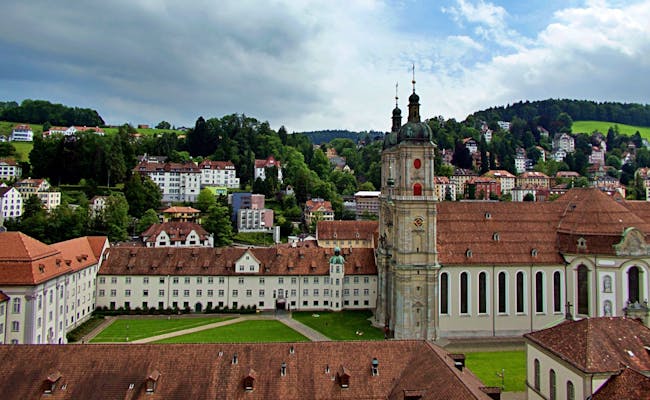 Dom und Klosterplatz in St. Gallen (Foto: Seraina Zellweger)
Dom und Klosterplatz in St. Gallen (Foto: Seraina Zellweger)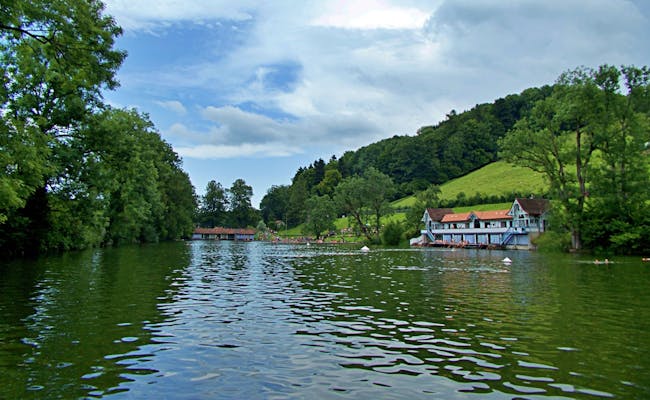 Drei Weihern oberhalb von St. Gallen (Foto: Seraina Zellweger)
Drei Weihern oberhalb von St. Gallen (Foto: Seraina Zellweger)Today, you’re in for some serious hiking and a ton of impressive mountain views. In the morning, catch the train to Wasserauen and hike up to Seealpsee, one of the three lakes in the Alpstein mountain range. Spend some time in this peaceful spot before moving on to Ebenalp.
On your way to Ebenalp, you’ll pass by a place you might have seen before. The famous Äscher restaurant. Ever since it was featured on National Geographic and on Ashton Kutcher’s Instagram, it‘s been completely overrun by its success. This sadly caused it to lose some of its former charm. However, it’s still a worthwhile place to snap a few photos and take a break.
At Ebenalp, you can choose between hiking back to Wasserauen or catching the cable car. If you still have it in you after this long day, you might like a quick stopover in Appenzell on your way to St. Gallen.
In case you hop off in Appenzell and are feeling brave, visit the little cheese store at Hauptgasse 13. But be warned, those smelly cheese fumes will knock your socks off the second you enter the store. There’s no way your feet will be able to compete with that odour. Not even after a full day of being trapped inside your trekking boots... 🙂
Oh, and don’t miss out on a piece of Appenzeller Biber, an iconic local sweet treat made of gingerbread and a honey almond filling. And before you ask: Nope. This Biber doesn’t have any famous Canadian relatives...
Also, if you’re a beer-lover, make sure to stop by the Locher brewery. They brew the popular Quöllfrisch beer that is consumed all across Switzerland.
In the evening, head back to St. Gallen and enjoy sleeping like a baby tonight. Fresh mountain air has a tendency to leave you peacefully exhausted.
As an alternative to hiking and crawling around in the Alpstein, you can head to Lake Constance instead and enjoy some downtime by the lake.
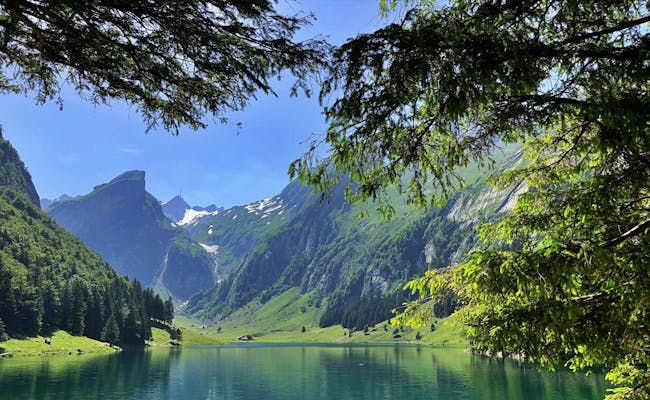 Bergpanorama beim Seealpsee (Foto: Seraina Zellweger)
Bergpanorama beim Seealpsee (Foto: Seraina Zellweger)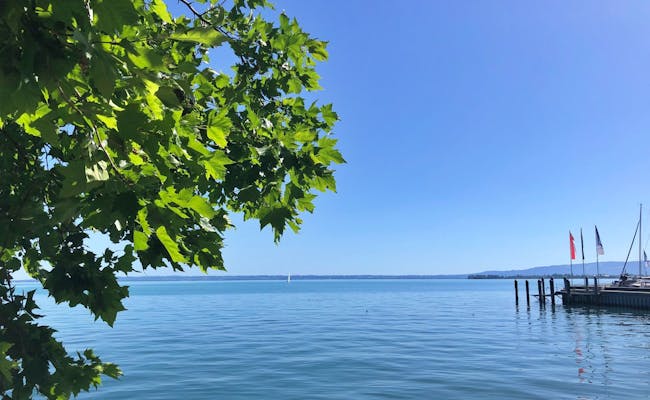 Ufer vom Bodensee (Foto: Seraina Zellweger)
Ufer vom Bodensee (Foto: Seraina Zellweger)What time you continue your journey today is entirely up to you. The train ride to Scuol takes just under three hours and even if you stick around in St. Gallen until the afternoon, you can still make it to Scuol in time.
So catch the train whenever you’re ready and travel to the marvellous Engadine region in the Canton of Grisons. The Engadine has to be one of the most magical places in Switzerland. Especially during autumn, when the leaves turn yellow, orange and red. But throughout the rest of the year, it’s just as fantastic a place to visit.
Enjoy the rest of your day exploring Scuol and get ready for a few days of being surrounded by mountains, forests, rivers, lakes and plenty of Swiss wildlife.
Ever seen a marmot? Chances of seeing one in the near future are pretty good.
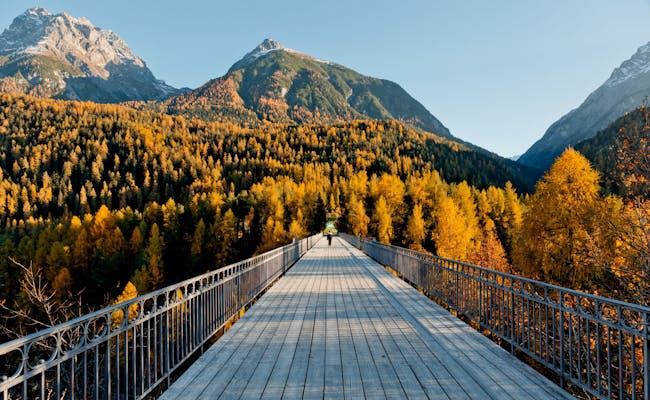 Wald bei Scuol im Herbst (Foto: Schweiz Tourismus Jan Geerk)
Wald bei Scuol im Herbst (Foto: Schweiz Tourismus Jan Geerk) Gasse in Engadiner Dorf (Foto: Seraina Zellweger)
Gasse in Engadiner Dorf (Foto: Seraina Zellweger)These next two days, you’re going to explore Switzerland’s only national park in all its glory. Leave your luggage in Scuol and only take what you need for your hiking excursion. If you ask nicely, they might let you leave your luggage at your accommodation in Scuol until you come back from the mountains tomorrow night.
The rules that apply when visiting Switzerland’s only National Park are pretty strict. There’s no leaving the marked trails, no taking plants with you, no making fires and so on. Once you arrive at the gates of the park, please read the signs or stop by the visitor centre in Zernez to make sure you’re prepared.
What you probably weren’t expecting is that visiting the park is free. Everything in Switzerland seems to be more expensive than anywhere else in the world. And yet, while you pay an entrance fee to pretty much every National Park in the world, ours is free. Pretty cool, right?
Since the only place to spend the night inside the Swiss National Park is a mountain hut called Chamanna Cluozza, you’ve got one task to accomplish today. Get to Chamanna Cluozza.
One hike we recommend starts half an hour from Scuol, in the village of Zernez. From there, you’ll spend a good three hours until you reach your camp for the night. The hike isn’t too straining. And if you’re not the most experienced hiker, just give yourself enough time and you should be alright.
Enjoy this evening far away from civilisation without phone reception and sitting around a table chatting to strangers. You’ve earned it.
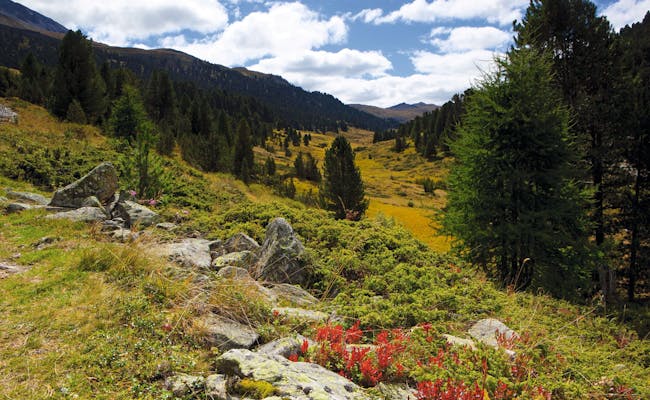 National Park S. Charl (Foto: Schweiz Tourismus Roland Gerth)
National Park S. Charl (Foto: Schweiz Tourismus Roland Gerth) Nationalpark der Schweiz (Foto: Seraina Zellweger)
Nationalpark der Schweiz (Foto: Seraina Zellweger)If you haven’t planned out today’s hike yet, ask the owners of Chamanna Cluozza for their recommendations. You have several further options of different difficulty levels to explore the National Park.
Or you can make your way straight back to Scuol after breakfast if you’ve had enough. It’s entirely up to you. If you’re looking for some relaxing alternatives to climbing up and down those steep mountains, the Engadine certainly has you covered.
For one, there are the hot springs in Scuol. Depending on how sore your legs are from your National Park endeavours, a few hours in this relaxing setting might just be what you need.
Otherwise, we suggest heading to one of the nearby villages. Like for instance Guarda or Sent. The stone houses you’ll encounter are characteristic to this part of Switzerland. And while you’re walking by those mighty buildings, keep an eye out for a bakery.
The Engadine is where the iconic Engadiner Nusstorte comes from. If you have a sweet tooth, we highly recommend you don’t leave before grabbing a slice or two. It’s heavy and rich. And it’s worth every single calorie.
After breakfast, leave Scuol and head to St. Moritz. You’ve got all day to explore this fancy mountain town today. St. Moritz is all about the outdoors. Summer and winter. Whether you’re into biking, hiking, stand up paddling, swimming, windsurfing, skiing, snowboarding, snowshoeing, cross-country skiing or just going for a walk, you’ll find your fix.
Only a short ride from St. Moritz lies Lake Silvaplana, a stunning place to cover some of those activities.
Another place worth visiting, since you have plenty of time in St. Moritz, is Ospizio Bernina. With 2253 metres (7397 feet) above sea level, this little railway station is the highest spot of the Bernina Express Line. Trains from St. Moritz leave every hour and lead you past several good-looking spots with lakes, glaciers and towering mountains.
On the culinary side, we recommend grabbing a bowl of Bündner Gerstensuppe. This barley soup with vegetables and meat is iconic to the Grisons. It warms you up like nothing else on a chilly day.
Back in St. Moritz, spend the rest of the day strolling through the town or hanging out by the lake. It’s not as charming and mystical as other villages in the area like Samedan or La Punt. But it’s great for window shopping and maybe, if you’re lucky, you’ll even spot a celebrity or two.
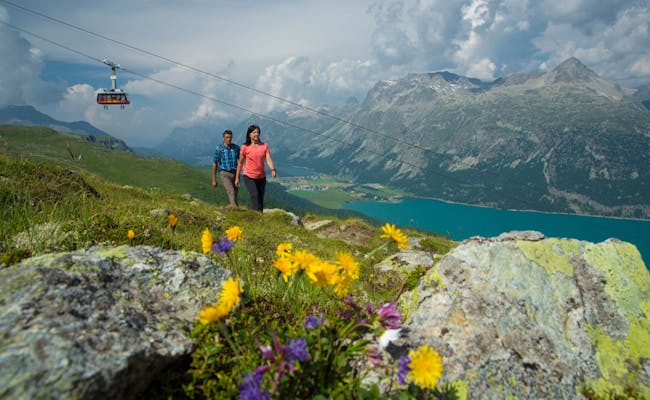 Wandern bei Corvatsch (Foto: Engadin St. Moritz Tourismus Christof Sonderegger)
Wandern bei Corvatsch (Foto: Engadin St. Moritz Tourismus Christof Sonderegger)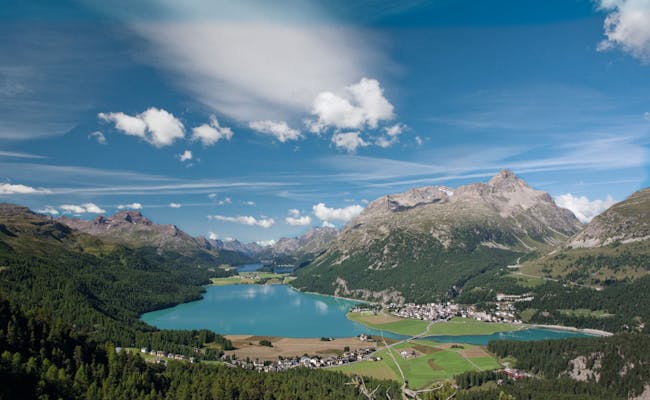 Panorama vom Silvaplanersee (Foto: Schweiz Tourismus Christof Sonderegger)
Panorama vom Silvaplanersee (Foto: Schweiz Tourismus Christof Sonderegger)If there’s anything you didn’t get to do yesterday, today’s your chance. The train ride back to Zurich takes just over three hours so there’s no rush to leave just yet. However, if you’ve seen it all and you’re ready to move on, you’re welcome to hop on the train and spend some time anywhere along the way between St. Moritz and Zurich.
One place you might like is the dreamy village of Bergün with its impressive stone buildings that are iconic to this area. You’ll arrive in Bergün right after navigating the confusing Albula Line, the part where the train overcomes the altitude by taking a few loops and tunnels through the mountains. As you look out the window, you’ll notice the train crosses sides of the valley while spiralling down the mountains.
Another place you might enjoy between St. Moritz and Zurich is Walenstadt. Or more precisely, Lake Walensee. This beautiful lake is the perfect stopover. It’s a stunning and mystical lake and, depending on the weather and the light reflection, it sometimes reminds you of a Scottish loch.
Spend the rest of the evening in Zurich and snack on some more Engadiner Nusstorte by the lakeshore or at Lindenhof.
 Reiseroute 5: Zürich - Luzern - Interlaken - Lausanne - Genf
Reiseroute 5: Zürich - Luzern - Interlaken - Lausanne - GenfHighlights on this itinerary:
Leave Zurich first thing in the morning and catch the train to Lucerne. Store your luggage either at the train station or at your accommodation and take the next train to Arth Goldau. From here, the Rigibahn – a cog railway that’s been around for over 150 years – takes you on a 45-minute ride to the top station Rigi Kulm.
Provided Mount Rigi isn’t veiled in clouds, you’ll be presented with spectacular views over the Alps, Lake Lucerne and other surrounding lakes. Just follow the signs to the viewing point after getting off at Rigi Kulm.
Once you’ve snapped enough photos, either take a break at the restaurant, catch the train down to Vitznau or go for a hike. With over 120 kilometres (75 miles) of hiking trails at your feet, you’re spoiled for choice here.
Upon arrival in Vitznau, the passenger ship to Lucerne will be waiting for you. Keep your camera within reach because this scenic and peaceful ride offers some more stunning views.
Back in Lucerne, spend the rest of the evening exploring the city or find a cosy spot by the lake to relax.
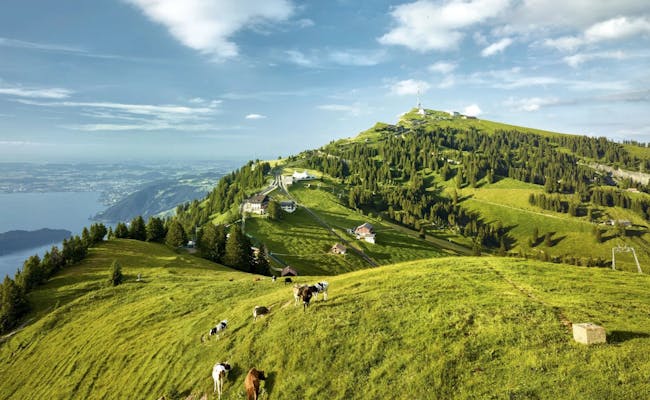 Ausblick vom grünen Rigi (Foto: Schweiz Tourismus Beat Brechbuehl)
Ausblick vom grünen Rigi (Foto: Schweiz Tourismus Beat Brechbuehl)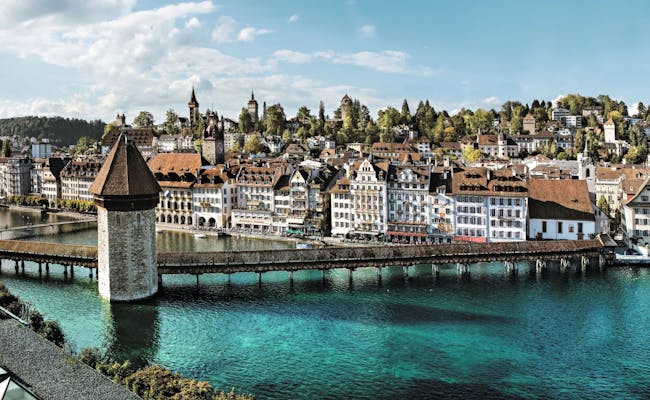 Berühmte Kapellbrücke in Luzern (Foto: Luzern Tourismus)
Berühmte Kapellbrücke in Luzern (Foto: Luzern Tourismus)You’ve got all day to explore Lucerne and its surroundings today. For a more detailed list of things to see and do, turn back to day 2 in itinerary No. 2.
In case you’re staying in the city, there are quite a few options as well. Either join a guided city tour, take a stroll through the old town, walk across the Kapellbrücke, hang out by the lake or visit the Glacier Garden with its famous Lion Monument. Leave for Interlaken on the Golden Pass train whenever you’re ready.
The Golden Pass Line is a popular scenic train route from Lucerne to Montreux and is served by several train companies. It connects the centre of Switzerland with the shores of Lake Geneva.
This panoramic journey leads past eight lakes, rides through six different cantons (the Swiss version of states), crosses three mountain passes and connects two language regions. Today’s leg between Lucerne and Interlaken is run by Zentralbahn and takes just under two hours.
Once you arrive in Interlaken, spend the evening in this popular yet very touristy town. Activities here are endless and if you want to enjoy this region to its fullest, you’ll be happy you have two full days here. So get ready for some action.
You’ve got more activities to choose from these next two days than you can wrap your head around. It all depends on your budget, but in an adrenaline-packed place like Interlaken, the sky’s the limit.
If even that...
Skydiving, paragliding, canyoning and jet boating are all popular activities that will get your adrenaline flowing.
Another option is to embark on a passenger ship cruise on either Lake Thun or Lake Brienz. Both rides come with incredible views that will make you wish you’d never have to leave.
If you’re looking for a stopover on one of the cruises, get off at either Giessbach (Lake Brienz), the Saint Beatus Caves or Spiez (Lake Thun).
The Jungfrau region around Interlaken is also an excellent playground for hikers. The amount of trails is nearly endless and whatever your fitness level and ambitions, you’ll find something to your taste.
Of course, the No. 1 destination everybody wants to see out here is the famous Jungfraujoch – aka Top of Europe. If you’re after a slightly more budget-friendly experience, we suggest looking into visiting Mount Schilthorn, Schynige Platte, Grindelwald First or Männlichen instead. The rides up to these mountains and the views from the top won’t disappoint you.
Other places of interest in and around Interlaken are: the open-air museum Ballenberg, the chocolate workshops at Funky Chocolate Club, the two mountain lakes Blausee or Oeschinensee or the Aare Gorge.
And let’s not forget those charming towns and villages like Brienz, Spiez, Thun, Lauterbrunnen or Grindelwald.
We could go on forever here but we guess this would only make you hate that you don’t have all week here.
 Brücke in der Stadt Interlaken (Foto: Seraina Zellweger)
Brücke in der Stadt Interlaken (Foto: Seraina Zellweger) Panorama von der Schynige Platte (Foto: Jungfraubahnen)
Panorama von der Schynige Platte (Foto: Jungfraubahnen)You’re in for plenty more scenic treats today. Once you leave Interlaken and head toward Zweisimmen, you’ll have Lake Thun to your right. For the best lake views, we recommend grabbing a seat on the right when you get on the train.
Just over one hour into the journey, you’ll need to transfer to a different train in Zweisimmen. That’s where the climb through the Bernese Oberland towards Gstaad begins. This region is an absolute dream for mountain-lovers and pretty much sums up what Switzerland is about. Lakes, mountains, lush meadows with grazing cows, glaciers, tons of hiking trails, wonderful landscapes and cute little villages are abundant in this area.
In Gstaad, you have several options to spend the afternoon. Since this area is a hiker’s paradise, you’re spoiled for choice here. One hike takes you to Lake Lauenensee, a mountain lake surrounded by moorland.
A trip that is easily doable from Gstaad is a visit to the impressive Glacier 3000. After a 35-minute bus ride to Col du Pillon, you’ll find yourself at the base of the cable car. Hop on the gondola and enjoy the ride. At the top, you’ll be presented with the most astonishing 360-degree views across the Alps.
On a clear day, you can see several huge players in the alpine scene like the Matterhorn, the Mont Blanc massif and the popular mountain-trio Eiger, Mönch and Jungfrau. If you’re brave enough, tackle the Peak Walk to Scex Rouge. This is the world’s first suspension bridge connecting two peaks. You’ll also find other activities on Glacier 3000 like the mountain coaster or a walk across the glacier.
In the evening, if you decide to wander through Gstaad, keep your eyes peeled for celebrities. This place is a playground for the rich and famous. Much like St. Moritz.
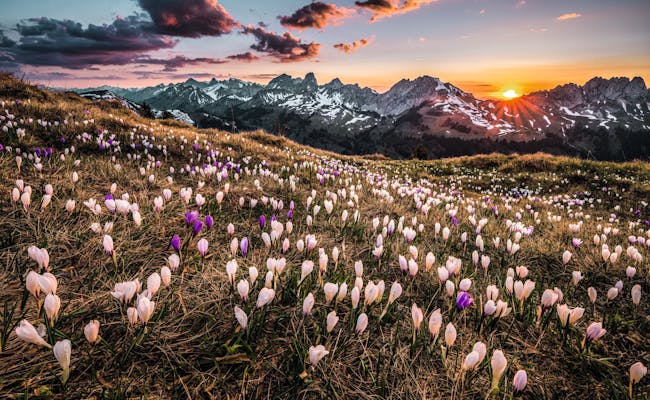 Blumenweise bei Zweisimmen (Foto: Schweiz Tourismus Martin Maegli)
Blumenweise bei Zweisimmen (Foto: Schweiz Tourismus Martin Maegli)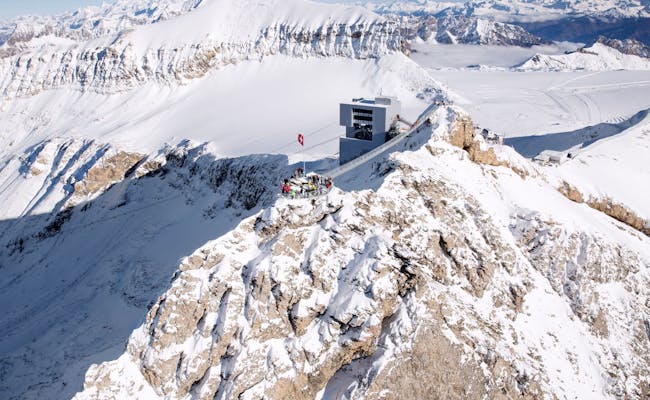 Glacier 3000 Peak Walk (Foto: Glacier 3000)
Glacier 3000 Peak Walk (Foto: Glacier 3000)Time to say goodbye to this beautiful region already. Catch the Golden Pass train again after breakfast and continue your scenic journey. After leaving the Bernese Oberland and coming down the hills, you’ll arrive in the French-speaking part of Switzerland.
Bienvenue...
The Golden Pass Line terminates in Montreux, where you’ll be spending the night. Enjoy the day in this wonderful area on the shores of Lake Geneva. Walk to the Promenade and check out the Freddie Mercury statue just outside the market hall.
In case you’re interested in castles, don’t miss out on visiting the famous Chillon Castle. To get there, either follow the Promenade by foot, catch a bus or take one of the regularly departing passenger ships.
Even if you’re not keen on going into the castle, we still recommend heading out there and spending some time by the lake. It’s a great place to hang out and take a bunch of jealousy-inducing pictures.
Alternatively, head in the opposite direction toward Vevey, where you’ll find a stunning riviera and many interesting museums. Only a short train ride west of Montreux, you’ll find the famous Lavaux vineyards, a UNESCO World Heritage site.
To fully experience the gorgeous views, get off in Cully or Epesses and follow the signposted footpath through the vineyards.
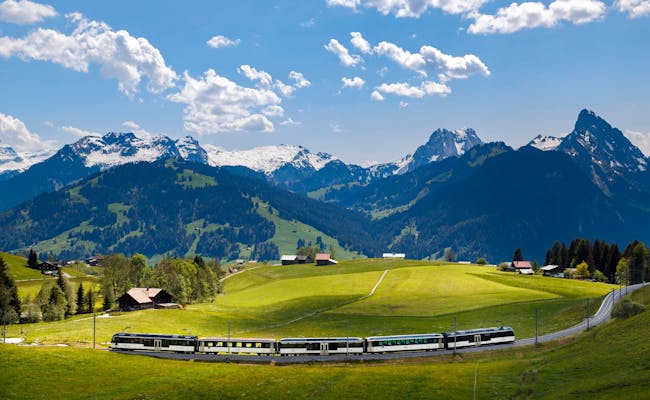 Golden Pass im Berner Oberland (Foto: Swiss Travel System)
Golden Pass im Berner Oberland (Foto: Swiss Travel System) Weinberge von Lavaux (Foto: Seraina Zellweger)
Weinberge von Lavaux (Foto: Seraina Zellweger)Today is all about cheese and chocolate. After all, that’s what Switzerland is famous for. So catch the train to Gruyères and get ready for some culinary and mediaeval action.
The Gruyère cheese factory is right behind the train station. For a small entrance fee, you can watch how the iconic Gruyère cheese is being made. Samples and tasting opportunities are included.
Once you’re done snacking, either catch the bus uphill or follow the path until you reach the village centre of Gruyères. This walk should take you around 20 minutes.
The main attraction in Gruyères is probably the castle, which is open to the public and costs 12 CHF to enter. But the hidden cobblestone alleys and the countless souvenir shops also tend to have people stick around longer than they expected.
After exploring Gruyères, and maybe grabbing a souvenir or two, you have the option to head to Broc and visit La Maison Cailler. Their visitor centre teaches you everything you need to know about Switzerland’s oldest chocolate brand. At the end of the tour, you’ll get to taste a lot of free samples.
More than you thought you could handle.
On your train ride back to Montreux, try to digest your cheese and chocolate overdose. Spend the rest of the day hanging out in Montreux.
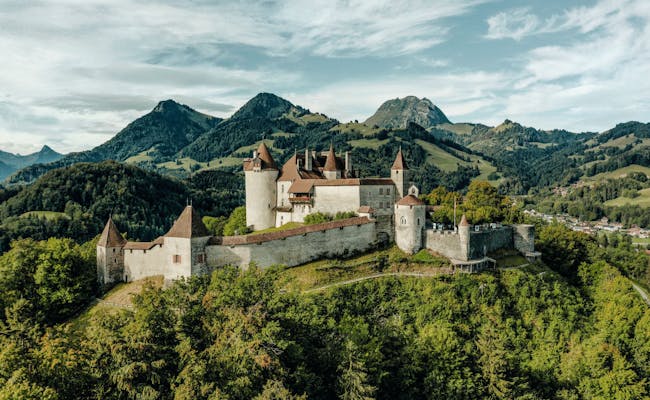 Burg Hügel von Gruyères (Foto: Schweiz Tourismus Silvano Zeiter)
Burg Hügel von Gruyères (Foto: Schweiz Tourismus Silvano Zeiter)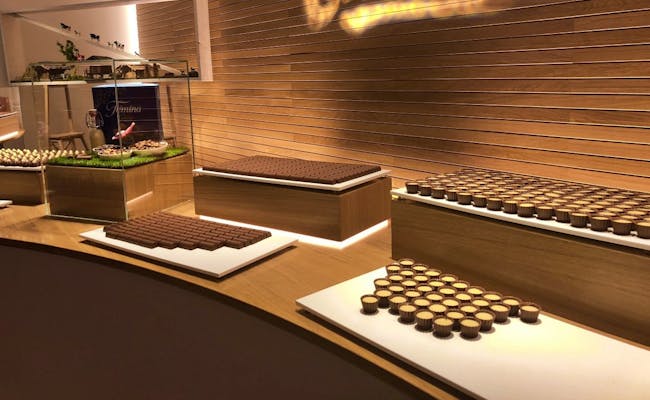 Degustation bei Cailler (Foto: Seraina Zellweger)
Degustation bei Cailler (Foto: Seraina Zellweger)Leave Montreux after breakfast and head to Lausanne. This picturesque old town is built on three hills and surrounded by numerous vineyards. You should definitely find enough to keep you busy for a few hours.
In case you would have liked to visit the Lavaux vineyards the day before yesterday but ran out of time, today’s another chance to give it a go.
Toward the end of the day, either head back to Zurich or travel on to Geneva. Whichever city it is you’re leaving Switzerland from.
 Reiseroute 6: Zürich - St. Gallen - Engelberg - Luzern
Reiseroute 6: Zürich - St. Gallen - Engelberg - LuzernHighlights on this itinerary:
In the morning, explore Zurich on your own, borrow a free bike with «Züri rollt» or join a guided city tour. After the tour, grab some take-away lunch and have it on the train to St. Gallen.
Spend the afternoon exploring the old town of St. Gallen. With the UNESCO listed Abbey District, its towering Cathedral and the impressive Abbey Library, this city has quite a few things to offer.
While you’re here, make sure you don’t miss a trip to the recreational area of Drei Weieren. To get there, either catch the Mühleggbahn or take the stairs. Alternatively, visit the wildlife park Peter & Paul or still your cultural thirst at one of the many museums.
By far the best place to relax is at Drei Weieren. Go for a refreshing swim to recover from the many steps you took up here or go for a stroll in the forest. You also get a fantastic view over the whole city, Lake Constance and all the way to Germany.
 Lindenhof an der Limmat in Zürich (Foto: Seraina Zellweger)
Lindenhof an der Limmat in Zürich (Foto: Seraina Zellweger)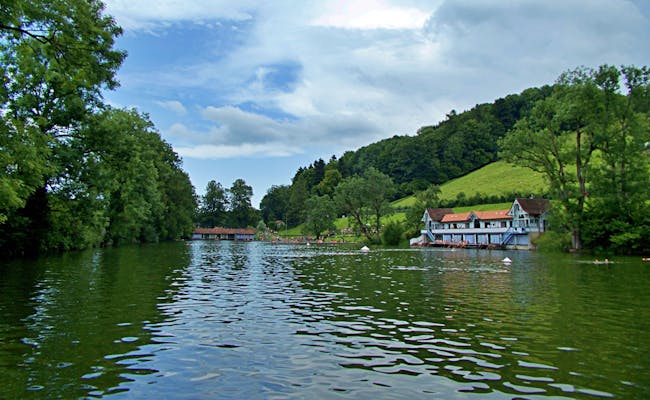 Drei Weihern oberhalb von St. Gallen (Foto: Seraina Zellweger)
Drei Weihern oberhalb von St. Gallen (Foto: Seraina Zellweger)The following two days are fully dedicated to exploring the Alpstein mountain range. Leave whatever luggage you won’t need in St. Gallen and get ready for some serious hiking.
The hiking options are absolutely endless in this mountain range. Whether you’d like to catch a glimpse of the famous Äscher restaurant or go for a swim in the charming Seealpsee, you’ll find your match.
Since you’ve got two days to spare, we’ll run you through one of our favourite hikes in this area. It starts in Brülisau, includes two mountain lakes, some fresh milk and cheese, maybe a night in a stable above the cows and definitely a pair of sore calves.
Firstly, make your way to Brülisau in the Canton of Appenzell Innerrhoden. From here, start your walk to the restaurant Ruhesitz, which you’ll reach halfway up a mountain called Hoher Kasten. From Ruhesitz, follow the signs pointing you toward Lake Sämtisersee. By now, you might be ready for a break. Spend as much time as you like hanging out by or inside this beauty.
From Sämtisersee, keep going until you reach Bollenwees by Lake Fälensee. If you’re looking for comfort, this mountain inn is where you can spend the night. They offer private rooms or dorms with showers as well as a restaurant. The views over the lake are unparalleled and after this long day of hiking, you’ll probably be more than happy to just stretch your legs and take in the stunning backdrop.
However, if you’re up for a bit of an adventure, keep going. Follow Lake Fälensee to the end and you’ll bump into Fälenalp, a little Alp where a farmer’s family takes their cows, goats and pigs to spend the summer. They offer beds in a big dorm in a stable above the cows and cook a rustic farmers’ dinner for you.
Everyone looking for a place to forget about this busy world out there will love coming here. In case you decide to stay at Bollenwees, we still recommend you walk to Fälenalp to see this magical place and to try their fresh goat cheese. Either today after settling in at Bollenwees or tomorrow before heading back to St. Gallen.
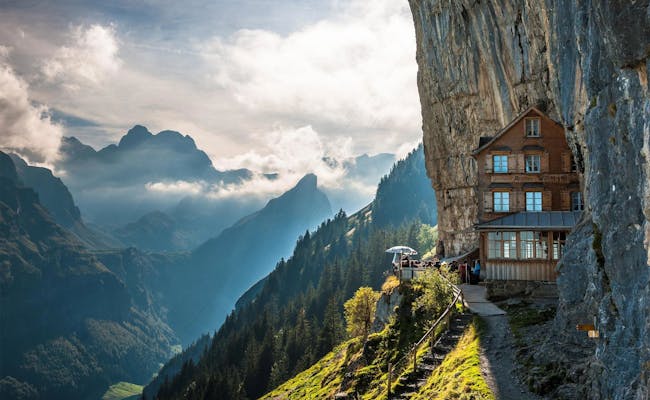 Gasthaus Aescher in der Felswand (Foto: MySwitzerland
Gasthaus Aescher in der Felswand (Foto: MySwitzerland Bergpanorama beim Fälensee (Foto: Pia Zellweger)
Bergpanorama beim Fälensee (Foto: Pia Zellweger)Wherever you spent last night, we hope you slept well in this fresh mountain air. You can head straight back to St. Gallen after breakfast, but it’s really up to you how you plan out your day. You haven’t exhausted your hiking options by far, so keep going for as long as you please.
One option is to climb to Bogartenmannli and terminate your hike in Wasserauen after passing Seealpsee. This should put you on the train to St. Gallen some time in the afternoon. Or you can just walk back to Brülisau via Sämtisersee and Brüeltobel. The world is your oyster here.
On your way back to St. Gallen, you might like a quick stopover in Appenzell, the charming capital of the Canton of Appenzell Innerrhoden. In case you’re feeling brave, visit the little cheese store at Hauptgasse 13. But be warned, those smelly cheese fumes will knock your socks off the second you enter the store.
There’s no way your feet will be able to compete with that odour. Not even after two full days of being trapped inside your trekking boots... 🙂
Oh, and don’t miss out on a piece of Appenzeller Biber, an iconic local sweet treat made of gingerbread and a honey almond filling. And before you ask: Nope. This Biber doesn’t have any famous Canadian relatives...
Also, if you’re a beer-lover, make sure to stop by the Locher brewery. They brew the popular Quöllfrisch beer that is consumed all across Switzerland.
In the evening, head back to St. Gallen and enjoy sleeping like a baby tonight. Spending a day or two in the mountains has a tendency to leave you peacefully exhausted.
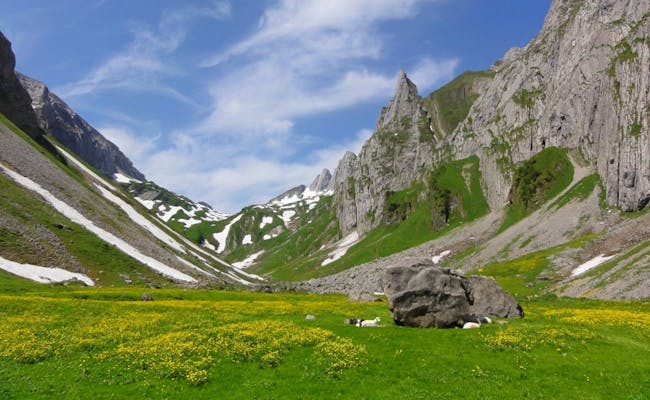 Panorama bei der Fälenalp (Foto: Seraina Zellweger)
Panorama bei der Fälenalp (Foto: Seraina Zellweger)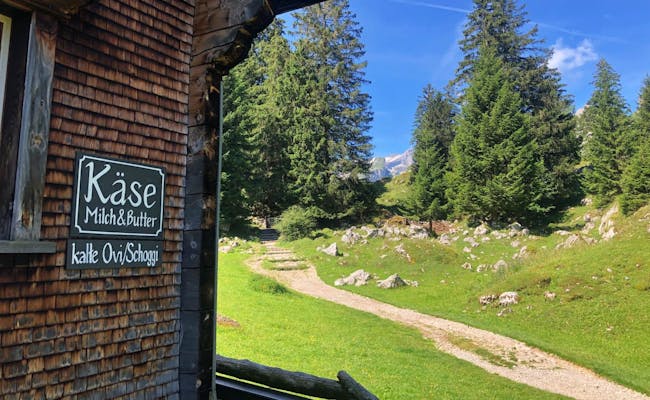 Berghütte der Alpkäserei (Foto: Seraina Zellweger)
Berghütte der Alpkäserei (Foto: Seraina Zellweger)It’s time to take it down a notch today. After two intense and possibly exhausting days in the Alpstein, take a relaxing trip to Lake Constance.
This lake is 63 kilometres (39 miles) long, up to 14 kilometres (8.7 miles) wide and shares its shores with Germany, Austria and Switzerland. It’s one of Europe’s biggest lakes and is very easy to reach from St. Gallen by train.
This tri-national area offers a considerable amount of sights and activities for you to discover. For one, there’s the picturesque town of Constance in Germany that’s just within walking distance from Kreuzlingen. Most Swiss go there for its cheap shopping, but Constance has more to offer than low-priced stores.
With its charming old town, a wide array of cafés, restaurants, ice cream places and peaceful spots to hang out by the lake, Constance certainly manages to attract visitors throughout the warmer months.
If you’re into fish and other creatures that live and dwell under water, the Sea Life is always a potential bad weather option.
Of course, you don’t need to leave the country to enjoy Lake Constance to its fullest. Visit one of the many beaches, go for a swim, catch a passenger ship, rent a stand up paddleboard, grab a bike and follow the trails or go for a walk along the lakeshore.
The Canton of Thurgau, which makes up most of the Swiss part along Lake Constance, is famous for its apple trees. One of the walks we recommend in this area is the Altnauer Apple Trail. It’s particularly idyllic when the trees bloom in April and May or then again during harvest time in autumn. The trail is basically divided into three separate trails, which all contain informative signs addressing different topics. Combine all three trails and you’ll know everything there is to know about apples. Oh, and options to buy and taste a selection of apple products are plentiful along the way, too.
Additional places of interest by Lake Constance are the towns of Romanshorn, Rorschach and Kreuzlingen. Once you’re done exploring the area, catch the train back to St. Gallen for one last night.
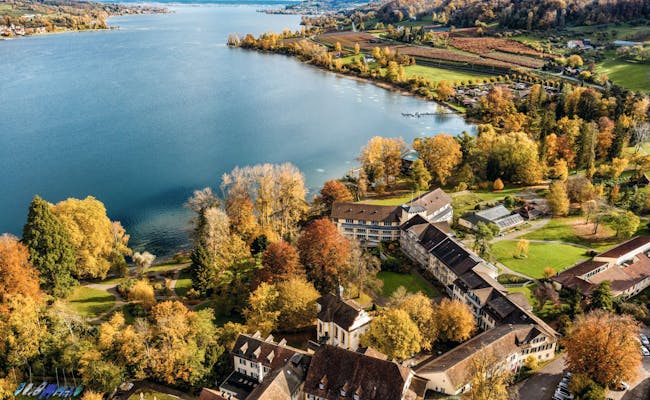 Panorama des Bodensee Ufers (Foto: Schweiz Tourismus Nico Schaerer)
Panorama des Bodensee Ufers (Foto: Schweiz Tourismus Nico Schaerer)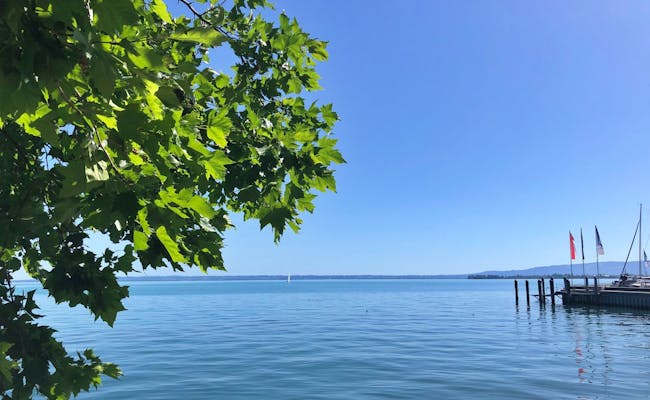 Bodensee Ufer Promenade (Foto: Seraina Zellweger)
Bodensee Ufer Promenade (Foto: Seraina Zellweger)You’ve probably seen enough of St. Gallen by now so grab your bags in the morning and catch the Voralpen-Express to Lucerne. Out of the many scenic train rides in Switzerland, this is one of the less touristy ones. It doesn’t come with fancy panorama windows and there’s no friendly voice pointing out what viaduct you just crossed.
But that doesn’t make it any less worth riding.
We recommend breaking up your journey halfway in and getting off in Rapperswil, a real hidden gem of a city. Head up to the castle, spend some time with the deer in the castle’s garden, go for a swim in Lake Zurich and walk along the idyllic esplanade. An excellent spot to relax is the lawn behind OST, the technical college of Rapperswil. You can’t miss it when you head toward the lake after leaving the train station.
If you’re looking for an easy walk, follow the wooden footbridge and the connecting walkway across the lake to Pfäffikon. In doing so, you’ll be completing three kilometres (1.8 miles) of the Camino de Santiago trail, a pilgrim route leading from different places across Europe to Santiago de Compostela in Spain.
Once you’re ready to move on, catch the next train to Lucerne and transfer to the train to Engelberg. This versatile mountain village is situated about 25 kilometres (15 miles) south of Lake Lucerne and lies at an altitude of 1.013 metres (3.323 feet) above sea level. At 3.239 metres (10.626 feet), towering over the other peaks surrounding Engelberg, is mighty Mount Titlis.
Since you’ll arrive in Engelberg mid- or late afternoon, there won’t be enough time to head up there right away. So let’s leave that until tomorrow to make sure you don’t feel rushed. Instead, what you can do this afternoon is check out the centre of Engelberg. Or more specifically, the Benedictine monastery.
This ancient monastery, which was founded in 1120, is still inhabited by 30-odd monks. You can either visit the premises on your own or join a guided tour.
Like so many places in the Swiss Alps, Engelberg has its focus on the outdoors. Unarguably the most popular destination in this area is Mount Titlis. From Engelberg, you’ll reach the top by catching two gondolas. One of them being the world’s first revolving aerial cableway. Expect to be presented with some impressive 360-degree views at the top. Alongside an impressive glacier cave and the exciting Titlis Cliff Walk by Tissot.
The hiking options in the area around Engelberg are also seemingly endless and cater to all kinds of preferences. One recommended hike is the so-called “Kitzelpfad” in Brunni. What literally translates to “tickle-path” requires you to take off your shoes and walk across different types of soil. And whilst your feet get tickled by nature, you’ll also be able to enjoy the perfect views of Mount Titlis.
Now what would a proper hike be without coming across a mountain lake or two...?
A slightly more advanced hike called Four-Lakes hike takes you past – you might have guessed it – four mountain lakes. Since this excursion takes almost five hours to complete, we recommend you only opt for it if you’re feeling fit enough.
For a more relaxing and less straining day, you might prefer the wheelchair accessible path around Engelberg. This two-hour walk starts at the monastery in the centre of Engelberg and leads all the way to the picturesque River Aa and back. Even though this walk doesn’t take you up into the peaks, it still comes with some pretty acceptable mountain views.
During winter, Engelberg turns into an absolute heaven for snow lovers. Whether you’re into skiing, snowboarding, snowshoeing, hiking, cross-country skiing, ice skating or sledging, you’ll have your expectations met. Engelberg is especially popular among freeriders.
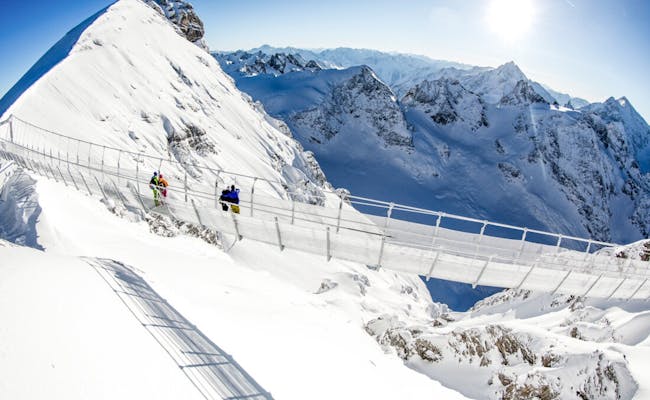 Titlis Cliff Walk bei Engelberg (Foto: Titlis Bergbahnen)
Titlis Cliff Walk bei Engelberg (Foto: Titlis Bergbahnen)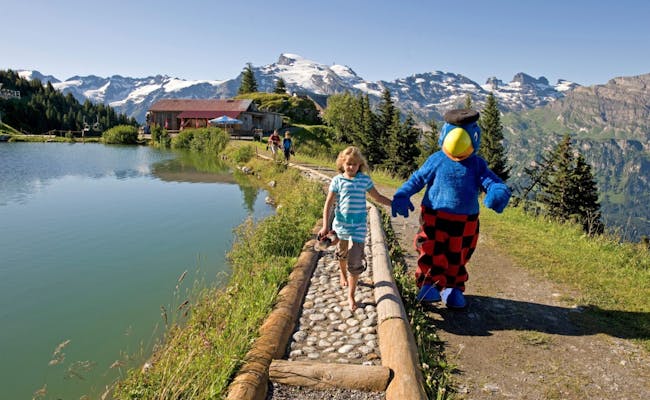 Globi Schatzsuche beim Brunni Kitzelpfad (Foto: Brunni-Bahnen Engelberg AG)
Globi Schatzsuche beim Brunni Kitzelpfad (Foto: Brunni-Bahnen Engelberg AG)If there’s anything you wanted to do in Engelberg yesterday but ran out of time, get that over with in the morning and leave for Lucerne afterwards. Travelling from Engelberg to Lucerne takes less than an hour and is very straightforward.
Once you arrive, store your bags at the train station and spend a few hours exploring this charming city. Walk across the Kapellbrücke, take a stroll through the old town, hang out by the lake or visit the Glacier Garden with its famous Lion Monument.
You’ve got all day here so take your time. For more ideas of things to do in Lucerne, turn back to day 2 on itinerary No. 2.
Luckily, you don’t have to leave Lucerne until the afternoon or even evening today. So spend the day doing whatever you didn’t get to do yesterday.
A popular day trip from Lucerne is heading up to Mount Rigi. To get there, store your luggage either at your accommodation in Lucerne or at the train station and take the train to Arth Goldau. From here, the Rigibahn – a cog railway that’s been around for over 150 years – takes you on a 45-minute ride to the top station Rigi Kulm.
Provided Mount Rigi isn’t veiled in clouds, you’ll be presented with spectacular views over the Alps, Lake Lucerne and other surrounding lakes. Just follow the signs to the viewing point after getting off at Rigi Kulm.
Once you’ve snapped enough photos, either take a break at the restaurant, catch the train down to Vitznau or go for a hike. With over 120 kilometres (75 miles) of hiking trails at your feet, you’re spoiled for choice here. Upon arrival in Vitznau, the passenger ship to Lucerne will be waiting for you. Keep your camera within reach because this scenic and peaceful ride offers some more stunning views.
Back in Lucerne, grab your bags and head back to Zurich.
 Reiseroute 7: Zürich - St. Moritz - Zermatt - Montreux - Bern
Reiseroute 7: Zürich - St. Moritz - Zermatt - Montreux - BernHighlights on this itinerary:
In the morning, explore Zurich on your own, borrow a free bike with «Züri rollt» or join a guided city tour. After the tour, grab some take-away lunch and have it on the train to Chur.
For better views of Lake Zurich and Lake Walensee on your way to Chur, we recommend grabbing a seat on the left when you get on the train. Spend an hour or two strolling through Chur – the capital of the Grisons – and get ready for the clean alpine air awaiting you in St. Moritz.
To get to St. Moritz, catch the train in Chur. Make sure you have your camera ready because you’ll be spoiled with panoramic views from start to finish. The Landwasser Viaduct and the curvy Albula Line are two highlights on this leg.
Spend the rest of the day hanging out in St. Moritz. If you find yourself feeling unusually sleepy tonight, thank the high altitude of 1822 metres (5977 feet) above sea level for that. It usually takes people a day or two to get accustomed to the thin air.
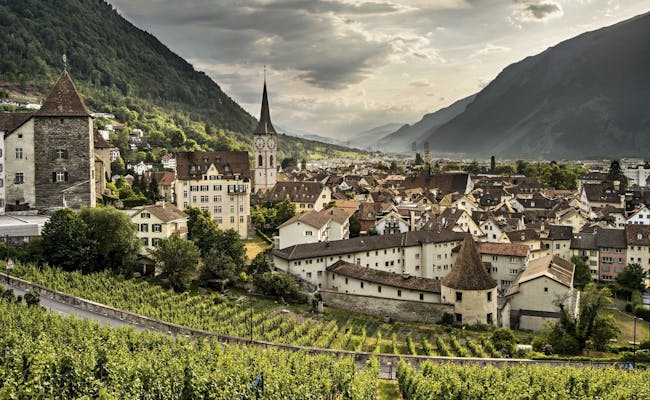 Panorama der Stadt Chur (Foto: Schweiz Tourismus Markus Buehler-Rasom)
Panorama der Stadt Chur (Foto: Schweiz Tourismus Markus Buehler-Rasom)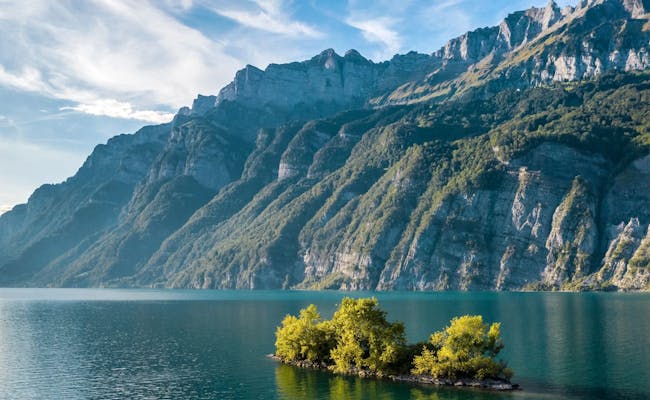 Kleine Insel auf dem Walensee (Foto: Schweiz Tourismus Roland Gerth)
Kleine Insel auf dem Walensee (Foto: Schweiz Tourismus Roland Gerth)Like Zermatt and Saas-Fee, St. Moritz is all about the outdoors. Summer and winter. Whether you’re into biking, hiking, stand up paddling, swimming, windsurfing, skiing, snowboarding, snowshoeing, cross-country skiing or just going for a walk, you’ll find your fix.
Only a short ride from St. Moritz lies Lake Silvaplana, a stunning place to cover some of those activities.
Another place worth visiting, since you have a full day in St. Moritz, is Ospizio Bernina. With 2253 metres (7397 feet) above sea level, this little railway station is the highest spot of the Bernina Express Line. Trains from St. Moritz leave every hour and lead you past several good-looking spots with lakes, glaciers and towering mountains.
On the culinary side, we recommend two things in the Grisons. Firstly, don’t miss out on a bowl of Bündner Gerstensuppe. This barley soup with vegetables and meat is iconic to the Grisons. It warms you up like nothing else on a chilly day.
Secondly, treat yourself to a slice of Engadiner Nusstorte. This heavy, delicious pastry puts the calories right back where you’ve been trying to lose them. But it’s so worth it.
Back in St. Moritz, spend the rest of the day strolling through the town. It’s not as charming and mystical as other villages in the area like Samedan or La Punt. But it’s great for window shopping and maybe, if you’re lucky, you’ll even spot a celebrity or two.
 Kanufahren auf dem St. Moritz See (Foto: Schweiz Tourismus Markus Aebischer)
Kanufahren auf dem St. Moritz See (Foto: Schweiz Tourismus Markus Aebischer) Bergstation bei St. Moritz im Winter (Foto: Schweiz Tourismus Philippe Wootli)
Bergstation bei St. Moritz im Winter (Foto: Schweiz Tourismus Philippe Wootli)Today, you’re going to complete the full Glacier Express from St. Moritz to Zermatt. This ride on “the world’s slowest express train” is a once in a lifetime experience and will spoil you with the best views the Alps have to offer.
The train leaves St. Moritz twice a day, with both trains departing in the morning. The schedule changes throughout the year and there are certain trains that don’t do the full journey between St. Moritz and Zermatt. To find your connection, please make sure you consult their current timetable.
There’s a reason why the Glacier Express is one of the most popular scenic railway routes in Switzerland. What makes this journey so memorable are the fantastic views you get left, right and centre throughout the whole ride. The train takes you across 291 bridges, through 91 tunnels, three cantons and two language regions.
It takes just over 8 hours to complete and depending on what time you leave St. Moritz, you’ll arrive in Zermatt between 5 and 6 pm. Whenever you do arrive, spend the rest of the day strolling through this little mountain town and enjoy the sight of the mighty Matterhorn.
Provided it’s not veiled in clouds.
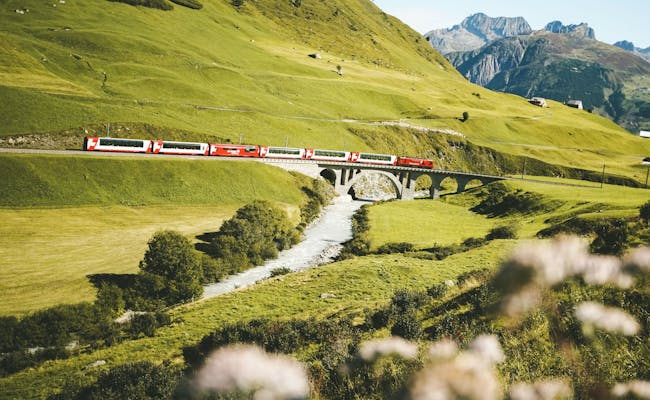 Zugfahrt mit dem Glacier Express (Foto: Swiss Travel System)
Zugfahrt mit dem Glacier Express (Foto: Swiss Travel System) Glacier Express Fahrt über eine Brücke (Foto: Swiss Travel System)
Glacier Express Fahrt über eine Brücke (Foto: Swiss Travel System)Zermatt is all about mountains and the outdoors. If you’ve come to Switzerland for our spectacular mountain views, you’re going to love it here.
Several hikes and walks of all difficulty levels take you places you didn’t even know existed. Like for instance the popular Zermatt five-lakes trail, which takes 2.5 hours to complete. It leads past five crystal clear mountain lakes with breathtaking views of the Matterhorn.
Another impressive, yet head spinning adventure, is walking across the world’s longest pedestrian suspension bridge in Randa. It stretches 494 metres (1.620 feet) across the valley.
Hello vertigo!
The circular track starts and finishes in Randa, 15 minutes by train from Zermatt.
In case you’d rather skip the hiking altogether and see some mountains the easy way, we recommend heading up to Gornergrat. After a ridiculously steep train ride, you’ll find yourself at an altitude of 3089 metres (10.135 feet) above sea level. Right in front of the Gorner Glacier and the Matterhorn.
 Wandern bei Zermatt mit Matterhorn (Foto: Schweiz Tourismus)
Wandern bei Zermatt mit Matterhorn (Foto: Schweiz Tourismus)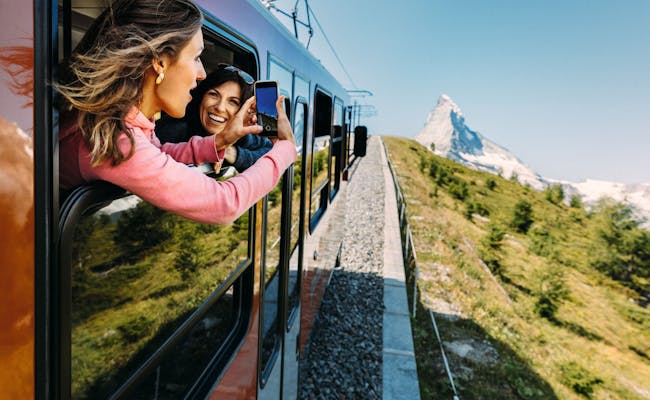 Fahrt mit der Gornergratbahn bei Zermatt (Foto: Schweiz Tourismus Giglio Pasqua)
Fahrt mit der Gornergratbahn bei Zermatt (Foto: Schweiz Tourismus Giglio Pasqua)Get ready for some more mountain action today. Whenever you’re done exploring Zermatt, catch the train and bus to Saas-Fee.
Saas-Fee, also known as the “pearl of the Alps”, is surrounded by Switzerland’s tallest mountains. As you arrive in this miraculous alpine village, you’ll find yourself in the midst of 13 mountains that are all over 4000 metres (13.120 feet) above sea level.
This can only mean one thing. You have to love the outdoors to come up here… If you’re visiting during summer, your hiking options are nearly infinite. Over 350 kilometres (217 miles) of hiking trails take you places you never even knew existed.
And while we’re at it, don’t forget to look out for marmots during your hike. Your chances of spotting a couple of those cute, chubby alpine inhabitants aren’t too slim up here.
But Saas-Fee isn’t only interesting during hiking season. If you’re here in winter, you can absolutely ski or snowboard yourself silly. And with Saas-Fee being at such high altitude, you’ll partially be skiing on top of a glacier. Not something you get to do every day.
Over 150 kilometres (93 miles) of prepared slopes will keep you busy for as long as you please. And while other ski resorts have been struggling with a lack of snow these past few years due to global warming, you’re almost certain to find enough snow in Saas-Fee due to its high altitude.
Knock yourself out enjoying the mountain views, the snow, the hikes, the marmots and the fresh air.
There’s certainly more than one day’s worth of things to do and see in Saas-Fee. Which means today is the perfect time to tick off anything you didn’t get to yesterday.
Once you’re ready to leave, catch the train and head to Montreux by Lake Geneva. Go to the Promenade and check out the Freddie Mercury statue just outside the market hall. If you’re keen on visiting the famous Chillon Castle, follow the Promenade to the castle or catch a bus. Passenger ships also take you there on a regular basis.
Alternatively, visit the famous Lavaux vineyards, a UNESCO World Heritage site. To fully experience the gorgeous views, get off in Cully or Epesses and follow the signposted footpath through the vineyards.
We’re aware that this is quite a full schedule for today and we don’t encourage you to try and cover it all. But now that you know your options, you’re flexible and can plan your day according to your preferences.
And maybe the weather... Plus, you’ve got all day tomorrow around here so take your time.
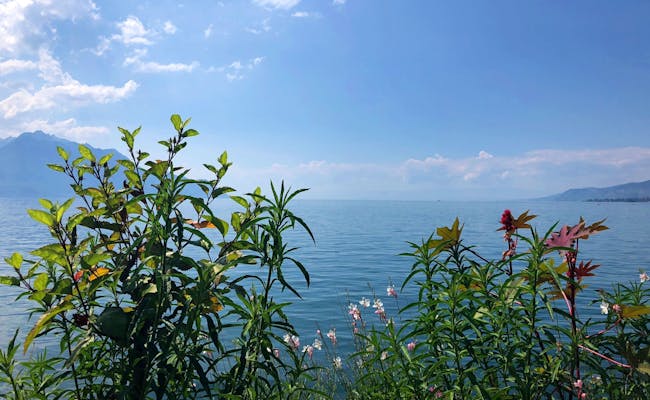 Promenade bei Montreux (Foto: Seraina Zellweger)
Promenade bei Montreux (Foto: Seraina Zellweger)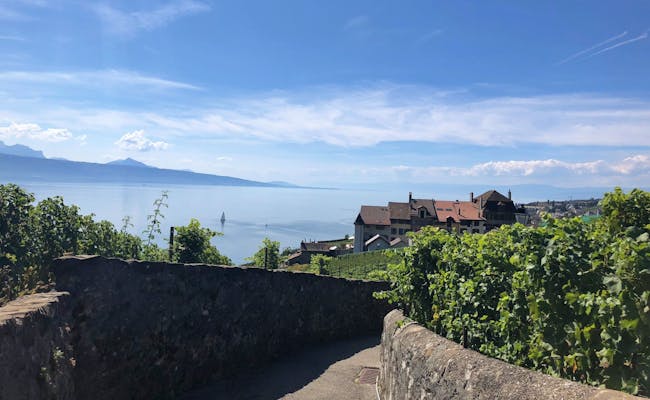 Steingasse bei Lavaux (Foto: Seraina Zellweger)
Steingasse bei Lavaux (Foto: Seraina Zellweger)Can you hear Lake Geneva calling your name? Follow that call today and tick off whatever’s left from yesterday’s list. Like visiting Château de Chillon, the Promenade in Montreux and of course the mind-blowing Lavaux vineyards.
Also, the city of Lausanne is fairly close to Montreux. The train ride takes less than half an hour and we recommend you go pay it a visit if you have time. Its picturesque old town is built on three hills and surrounded by numerous vineyards. This city right by Lake Geneva is home to the International Olympic Committee, as well as Switzerland’s only metro.
Since you’re spending today right by Switzerland’s largest lake, you also have the option to go on a boat cruise. Spending a few hours on Lake Geneva is the perfect way to wind down and not rush from one place to another for a change.
Another pretty promising option for today is to pay Gruyères and Broc a visit for some serious cheese and chocolate action. If this is something you’d be interested in, turn back to day 7 on itinerary No. 5. Just make sure you leave for this trip on an empty stomach.
As you can see, there are plenty of activities in the area to keep you busy for a day before you settle down in charming Montreux for another night.
It’s time to say goodbye to the wonderful Lake Geneva region already and get a move on to Bern. Before finishing your trip in Zurich (or Geneva) tonight, you’ve got a day to explore Switzerland’s capital.
Store your luggage at the train station in Bern. After that, you’ve got a few hours to explore this UNESCO certified city. Join a guided city tour or explore Bern on your own. Take a stroll through the old town, head to the bear park, check out the Bundeshaus (House of Parliament) and walk back to Rosengarten for the views.
You can also visit Gurten – Bern’s backyard mountain – see some animals at Dählhölzli wildlife park or visit the botanical garden. Alternatively, catch the elevator at the train station to hang out at Grosse Schanze or go for a swim either in the River Aare or at Weyermannshaus.
Toward the end of the day, catch the train to Zurich or Geneva. Whichever city it is you’re leaving Switzerland from.
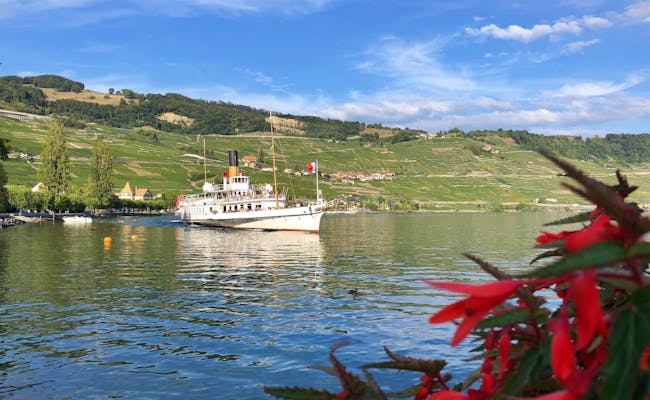 Schifffahrt auf dem Genfersee (Foto: Seraina Zellweger)
Schifffahrt auf dem Genfersee (Foto: Seraina Zellweger)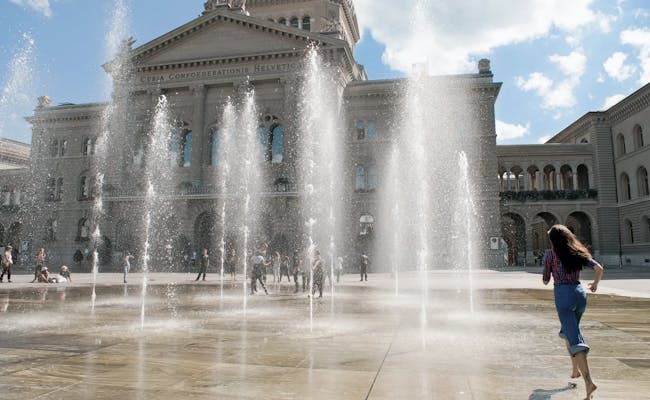 Das Bundeshaus in Bern (Foto: Schweiz Tourismus Gian Marco Castelberg Maurice Haas)
Das Bundeshaus in Bern (Foto: Schweiz Tourismus Gian Marco Castelberg Maurice Haas) Reiseroute 8: Genf - Lausanne - Montreux - Bern
Reiseroute 8: Genf - Lausanne - Montreux - BernHighlights on this itinerary:
In the morning, explore Geneva on your own, borrow a free bike with «Genève Roule» or join a guided city tour. After the tour, buy some take-away lunch and have it on the train to Nyon.
This mediaeval town by the shore of Lake Geneva is surrounded by a couple of charming vineyards. Follow the path through the vineyards to Nyon Castle to take in the view. After your lunch break, catch the train to Lausanne. Check in to your accommodation and make the most of your free Lausanne Transport Card.
Lausanne’s picturesque old town is built on three hills and surrounded by numerous vineyards. It’s home to the International Olympic Committee, as well as Switzerland’s only metro.
To hear something interesting, head to the Cathedral between 10 pm and 2 am and observe the tower. Night guards have been shouting out the current time in the middle of the night from up there since 1405.
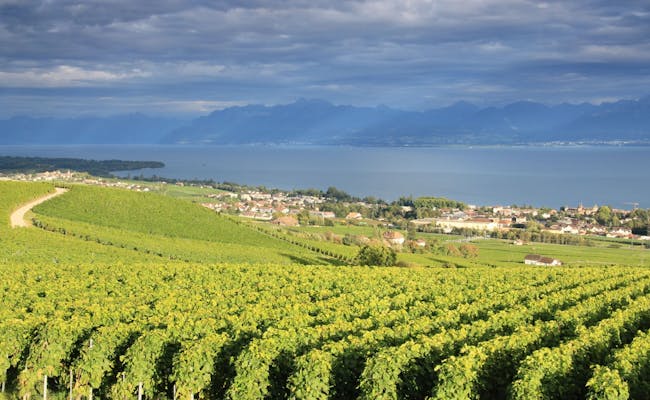 Weinberge von Nyon am Genfersee (Foto: MySwitzerland)
Weinberge von Nyon am Genfersee (Foto: MySwitzerland) Ausblick auf Lausanne (Foto: Régis Colombo)
Ausblick auf Lausanne (Foto: Régis Colombo)After breakfast, buy enough food for the day and head straight to Le Pont, a village in the Valleé de Joux. The train ride from Lausanne to the valley takes roughly an hour. Vallée de Joux is part of the Jura mountains and offers countless hiking options. In the centre of the valley, you’ll find a peaceful lake called Lac de Joux.
By far the most popular spot in the area is the distinctive mountain of Dent de Vaulion. Hiking the circular path from Le Pont takes around three hours. The views from Dent de Vaulion across the Vallée de Joux, all the way to Lake Geneva and way into France, make this place extra special.
Since you’ve got all day up here, spend as much time in the area as you like. Hang out by Lac de Joux, walk the path around the lake or do whatever else your heart desires. Whenever you feel like it, catch the train back to Lausanne and spend the rest of the day exploring the city.
If you’re in for a bit of a challenge, we recommend hiking to Creux du Van instead. This natural, one-kilometre wide amphitheatre got its shape from constant erosion by water and ice. Marmots, mountain goats, deer and various birds inhabit this area.
The starting point of the hike is in Noiraigue, a village that takes roughly an hour and a half to reach from Lausanne. Hiking to Creux du Van is pretty tough and will take up to five hours. Spend as much time as you like at the amphitheatre before heading back to Noiraigue and Lausanne.
Of course, Switzerland gets its fair share of bad weather and we don’t suggest you do this hike if it’s raining. The rocks can get slippery and dangerous when they’re wet and we don’t want you to get hurt!
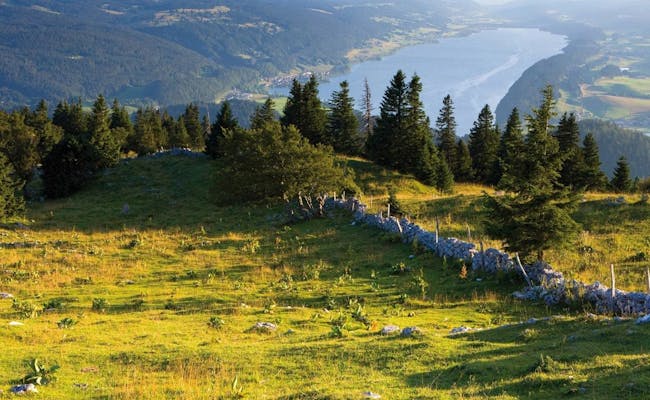 Panorama vom Lac de Joux (Foto: Schweiz Tourismus Roland Gerth)
Panorama vom Lac de Joux (Foto: Schweiz Tourismus Roland Gerth)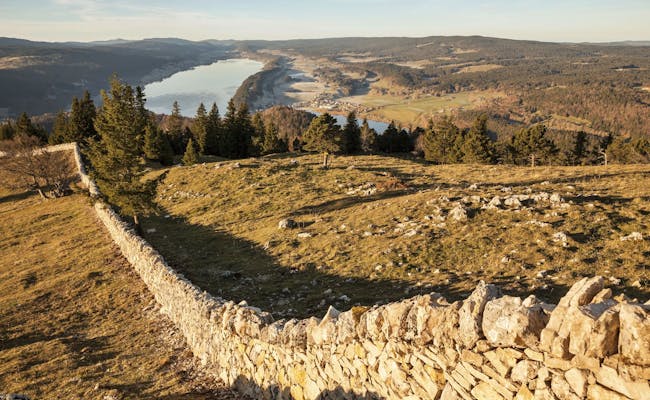 Ausblick vom Dent de Vaulion (Foto: Schweiz Tourismus Max Schmid)
Ausblick vom Dent de Vaulion (Foto: Schweiz Tourismus Max Schmid)In the morning, cover some more ground in Lausanne. Before you leave for Bern, make sure you spend some quality time in one of our favourite spots in Switzerland. Only a short train ride east of Lausanne, you’ll find the famous Lavaux vineyards, a UNESCO World Heritage site.
To fully experience the gorgeous views, get off in Cully or Epesses and follow the signposted footpath through the vineyards. The views across Lake Geneva are unparalleled and will take your breath away.
After your little excursion, go back to Lausanne to pick up your luggage. From there, a direct train takes you to Bern in just over an hour. You’ve got the rest of the day to roam the streets of our capital city. Take a stroll through the old town, head to the bear park, check out the Bundeshaus (House of Parliament) and walk up to Rosengarten for the views.
You can also visit Gurten – Bern’s backyard mountain – see some animals at Dählhölzli wildlife park or visit the botanical garden. Alternatively, catch the elevator at the train station to hang out at Grosse Schanze or go for a swim either in the River Aare or at Weyermannshaus. In the evening, we recommend you walk (or catch the bus) back up to Rosengarten for some impressive night views.
After breakfast, catch the train and venture to the quaint little town of Morat. This ride will only take you half an hour and you won’t even need to transfer. Morat itself is tiny and won’t take you long to figure out. Spend a few moments strolling through its historic town centre and stretch your legs by the lake.
This area is perfect for biking, hiking, swimming or just hanging out by the lake as well.
By the way, you’ll find Europe’s longest freshwater beach at Lake Morat in Salavaux. This might not impress anyone who grew up by the sea, but for a land-locked country like Switzerland, this is a big deal...
Once you’ve seen enough of Morat, travel on to Neuchâtel. Spend the afternoon exploring this beautiful city with its lake views and steep alleyways. For some additional great views, head up to Chaumont, Neuchâtel’s backyard mountain.
The funicular leaves from Le Coudre and takes you to the summit. From the summit, you can hike down to Cressier via Trois Cheminées. From Cressier, the bus will take you back to Neuchâtel. Alternatively, go for a walk around Chaumont and catch the funicular back down.
Toward the end of the day, make your way back to Bern and enjoy another night in Switzerland’s capital.
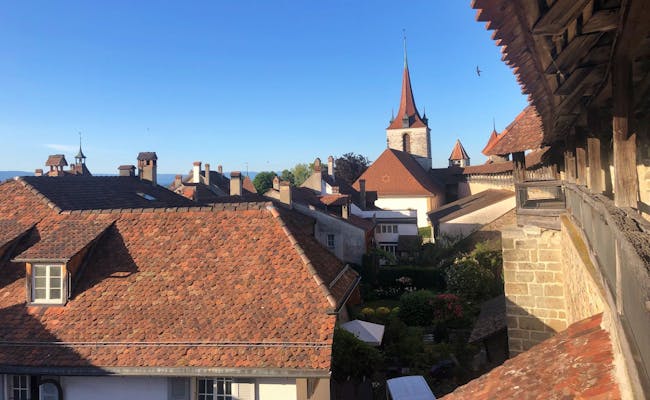 Stadtmauer von Murten (Foto: Seraina Zellweger)
Stadtmauer von Murten (Foto: Seraina Zellweger)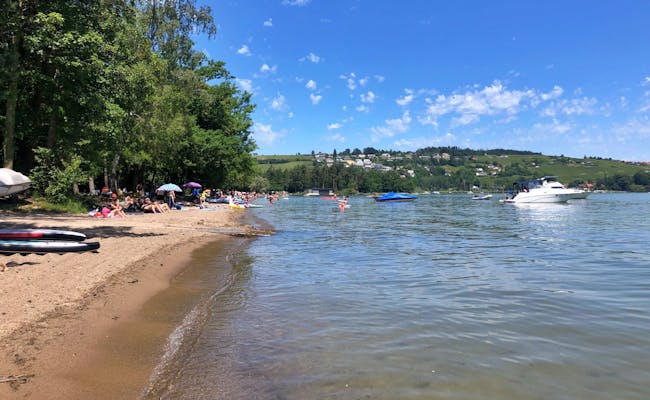 Badestrand in Salavaux (Foto: Seraina Zellweger)
Badestrand in Salavaux (Foto: Seraina Zellweger)Bern is conveniently located in close proximity to a variety of breathtaking destinations. For one, there’s Thun and Interlaken, which are two wonderful places to visit for some spectacular lake and mountain views.
If you’re into mountain lakes, you’re in luck, too. Lake Oeschinensee and Blausee are both within reach from Bern and more than worth a trip. The crystal clear water in both lakes will leave you breathless.
Only half an hour west of Bern lies the mediaeval city of Fribourg. If you decide to head over there, follow the citywalk signs leading you through this mighty old town. The signs will lead you up and down some very steep alleyways, across ancient wooden bridges, down to the River Saane and past the city’s very own funicular. For an even better view of your surroundings, tackle the 365 steps to the tower of the Cathedral. The River Saane at the bottom of the city is a great spot to stretch your legs and treat yourself to a snack.
Technically, you could take this even further and head to Gruyères and Broc for some typical Swiss cheese and chocolate. Whatever you end up doing today and whenever you’re ready, head back to Bern for your last night in the city.
 Blick auf die Stadt Bern (Foto: Bern Welcome)
Blick auf die Stadt Bern (Foto: Bern Welcome)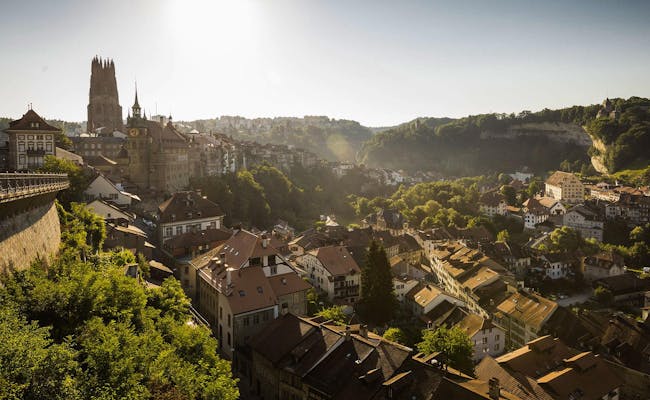 Aussicht von Fribourg (Foto: Freiburg Tourismus)
Aussicht von Fribourg (Foto: Freiburg Tourismus)You’re probably ready to leave Bern by now. So grab your bags in the morning and hop on the train to Gstaad. You’re in for plenty of scenic treats today. From Spiez to Zweisimmen and onward to Gstaad, you’ll be travelling on the Golden Pass Line. This popular scenic train route connects the centre of Switzerland with the shores of Lake Geneva.
After your second transfer in Zweisimmen, the climb through the Bernese Oberland towards Gstaad begins. This region is an absolute dream for mountain-lovers and pretty much sums up what Switzerland is about. Lakes, mountains, lush meadows with grazing cows, glaciers, tons of hiking trails, wonderful landscapes and cute little villages are abundant in this area.
This is why you’ll be spending two nights up here. Get off in Gstaad, check into your accommodation and head out to explore the Alps. Your hiking options are endless. Find a hike that suits your fitness level and enjoy the views. By the way, Lake Lauenensee is only one of the popular places you can visit up here.
In the evening, if you decide to wander through Gstaad, keep your eyes peeled for celebrities. This place is a playground for the rich and famous. Much like St. Moritz.
If there was ever a day when you needed your camera, it’s today. The mountain panorama awaiting you at your destination is unparalleled, so make sure your battery is fully charged.
The destination we're talking about is the impressive Glacier 3000, which is very easy to access from Gstaad. After a 35-minute bus ride to Col-du-Pillon, you’ll find yourself at the base of some seriously impressive mountains.
Hop on the cable car and enjoy the ride. At the top, you’ll be presented with the most astonishing 360-degree views. On a clear day, you can see several huge players in the alpine scene like the Matterhorn, the Mont Blanc massif and the popular mountain-trio Eiger, Mönch and Jungfrau.
If you’re brave enough, tackle the Peak Walk to Scex Rouge. This is the world’s first suspension bridge connecting two peaks. Crossing this bridge is an experience you’ll likely never forget.
Depending on what time you arrive back in Gstaad, spend a couple more hours strolling through the town or set out on another hike before enjoying one more night in the Bernese Alps.
 Glacier 3000 Peak Walk Tissot (Foto: Glacier 3000)
Glacier 3000 Peak Walk Tissot (Foto: Glacier 3000)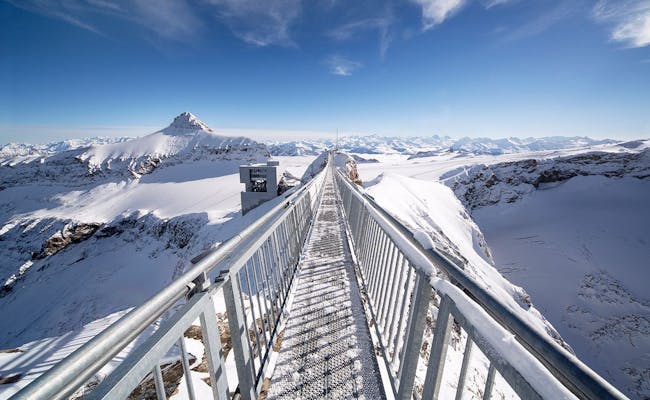 Ausblick Glacier 3000 Peak Walk (Foto: Glacier 3000)
Ausblick Glacier 3000 Peak Walk (Foto: Glacier 3000)Time to say goodbye to this beautiful region. Catch the Golden Pass train after breakfast and continue your scenic journey to Montreux, where you have a couple of hours before travelling back to Geneva. Head to the Promenade of Montreux and check out the Freddie Mercury statue just outside the market hall.
In case you’re interested in castles, don’t miss out on visiting the famous Chillon Castle. To get there, either follow the Promenade by foot, catch a bus or take one of the regularly departing passenger ships.
Even if you’re not keen on going into the castle, we still recommend heading out there and spending some time by the lake. It’s a great place to hang out and take a bunch of jealousy-inducing pictures.
Head back to Geneva toward the end of the day and spend the evening in Switzerland’s second largest city.
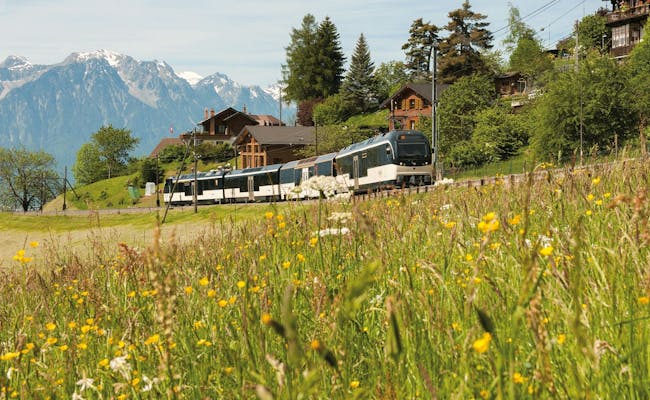 Golden Pass Zug in Gstaad (Foto: Swiss Travel System)
Golden Pass Zug in Gstaad (Foto: Swiss Travel System) Genfer Stadtbild von oben (Foto: MySwitzerland)
Genfer Stadtbild von oben (Foto: MySwitzerland) Reiseroute 9: Genf - Lausanne - Bern - Schaffhausen - St. Gallen - Rapperswil - Zürich
Reiseroute 9: Genf - Lausanne - Bern - Schaffhausen - St. Gallen - Rapperswil - ZürichHighlights on this itinerary:
In the morning, explore Geneva on your own, borrow a free bike with «Genève Roule» or join a guided city tour. After the tour, buy some take-away lunch and have it on the train to Nyon.
This mediaeval town by the shore of Lake Geneva is surrounded by a couple of charming vineyards. Follow the path through the vineyards to Nyon Castle to take in the view. After your lunch break, catch the train to Lausanne. Check in to your accommodation and make the most of your free Lausanne Transport Card.
Lausanne’s picturesque old town is built on three hills and surrounded by numerous vineyards. It’s home to the International Olympic Committee, as well as Switzerland’s only metro.
To hear something interesting, head to the Cathedral between 10 pm and 2 am and observe the tower. Night guards have been shouting out the current time in the middle of the night from up there since 1405.
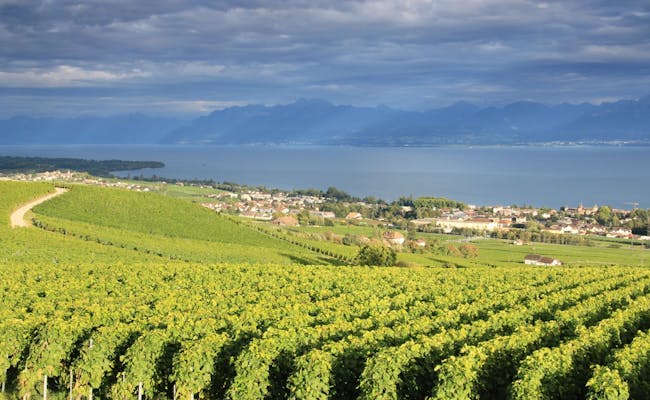 Weinberge von Nyon am Genfersee (Foto: MySwitzerland)
Weinberge von Nyon am Genfersee (Foto: MySwitzerland)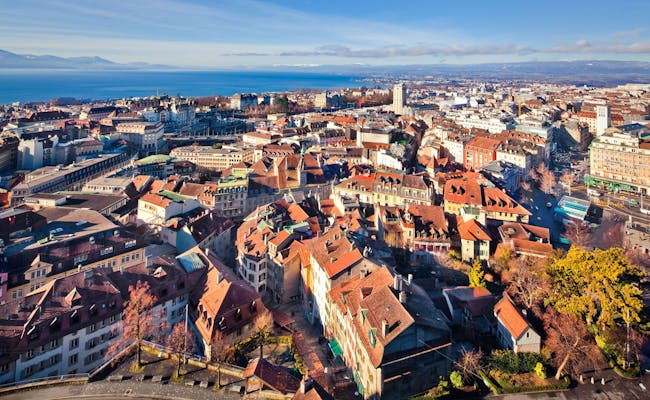 Stadtbild von Lausanne (Foto: Régis Colombo)
Stadtbild von Lausanne (Foto: Régis Colombo)After breakfast, catch the train and head to Montreux, where you spend a couple of hours exploring the town, walking along the Promenade or visiting Château de Chillon. Around lunchtime, travel to the very touristy yet wonderful, quaint little village of Gruyères. The ride between Montreux and Montbovon is served by regular regio trains as well as the famous Golden Pass Line.
Since Gruyères is highly popular with tourists, it can sometimes get a bit crowded. But like with every busy place, there’s a reason. And in this case, the reason is a mediaeval village and cheese.
Lots of cheese!
The Gruyère cheese factory is right behind the train station and for a small entrance fee, you get to watch how the iconic Gruyère cheese is being made. Samples and tasting opportunities are included.
Once you’re done snacking, either catch the bus uphill or follow the path until you reach the village centre of Gruyères. This walk should take you around 20 minutes. After exploring the hidden cobblestone alleys, checking out the castle and maybe grabbing a souvenir or two, you have the option to head to Broc and visit La Maison Cailler.
Their visitor centre teaches you everything you need to know about Switzerland’s oldest chocolate brand and at the end of the tour, you’ll get to taste a lot of free samples.
More than you thought you could handle.
On your train ride back to Lausanne, try to digest your cheese and chocolate overdose and get ready to spend the night by Lake Geneva.
Spend the morning covering some more ground in Lausanne or visit the stunning nearby Lavaux vineyards. Whenever you’re ready to move on, catch the train to Fribourg. In Fribourg, follow the city-walk signs leading you through this mighty old town. The signs will lead you up and down some very steep alleyways, across ancient wooden bridges, down to the River Saane and past the city’s very own funicular.
For an even better view of your surroundings, tackle the 365 steps to the tower of the Cathedral. The River Saane at the bottom of the city is a great spot to stretch your legs and treat yourself to a snack.
Getting to Bern from Fribourg takes less than half an hour. Spend the rest of the evening strolling through the UNESCO listed old town of Bern. For an impressive night view over Bern, we recommend heading up to Rosengarten.
 Panorama von Fribourg (Foto: Freiburg Tourismus)
Panorama von Fribourg (Foto: Freiburg Tourismus) Glockenturm Gasse in Bern (Foto: Schweiz Tourismus Giglio Pasqua)
Glockenturm Gasse in Bern (Foto: Schweiz Tourismus Giglio Pasqua)Today, it’s time to travel north and check out the Cantons of Neuchâtel and Jura. After breakfast, head straight to La Chaux-de-Fonds in the Canton of Neuchâtel. Le Corbusier, one of the most influential architects of the 20th century, was born here. And since this city was the centre of the Swiss watchmaking industry for over 100 years, it only makes sense for the International Clock Museum to be up here.
Another characteristic element to La Chaux-de-Fonds, apart from clocks and watches, is its chessboard-shaped outline. When the city was destroyed by a fire in the 19th century and they had to rebuild it from scratch, they introduced the unusual framework you’ll find today. Unusual for Switzerland, that is.
On your way back to Bern, make sure you stop over in Courtelary, a tiny little place in the Canton of Jura. This inconspicuous village is by no means as innocent as it seems. It’s home to Camille Bloch, the company behind two absolute Swiss favourite chocolate brands.
Ragusa and Torino.
Their visitors’ centre is a fantastic place to buy all different kinds of their delicious chocolate creations. And their exhibition doesn’t stop at telling you about the ups and downs of this family business since its early beginnings in 1926.
It also includes a mouth-watering demo station where two chocolatiers make Ragusa and Torino bars right in front of you. Needless to say you’ll be able to taste their mouth watering outcome only minutes after it’s cooled off.
Take your time enjoying some of the best chocolate before you head back to Bern.
Since you haven’t had too much time to hang out in Bern yet, give yourself a few hours to explore our capital city before travelling to Schaffhausen.
Join a guided city tour or explore Bern on your own. Take a stroll through the old town, head to the bear park, check out the Bundeshaus (House of Parliament) and walk up to Rosengarten for the views.
You can also visit Gurten – Bern’s backyard mountain – see some animals at Dählhölzli wildlife park or visit the botanical garden. Alternatively, catch the elevator at the train station to hang out at Grosse Schanze or go for a swim either in the River Aare or at Weyermannshaus.
Around lunchtime, catch the train to Schaffhausen and drop your bags at your accommodation before you head out again. The main attraction in the area are the mighty Rhine Falls. They attract visitors from all over the world and are one impressive force of nature. Access to the falls is free from the northern shore, while seeing them from Laufen Castle in the south costs 5 CHF. Spend however long you like getting soaked in the mist of the Rhine Falls before moving on to Schaffhausen.
Schaffhausen has a charming old town with an impressive total of 171 bay windows, which is more than any other Swiss city can account for. Once you’re done chasing them all down and exploring the rest of Schaffhausen, head up to Munot and enjoy the view over the city.
 Grösster Wasserfall Europas: der Rheinfall (Foto: Seraina Zellweger)
Grösster Wasserfall Europas: der Rheinfall (Foto: Seraina Zellweger)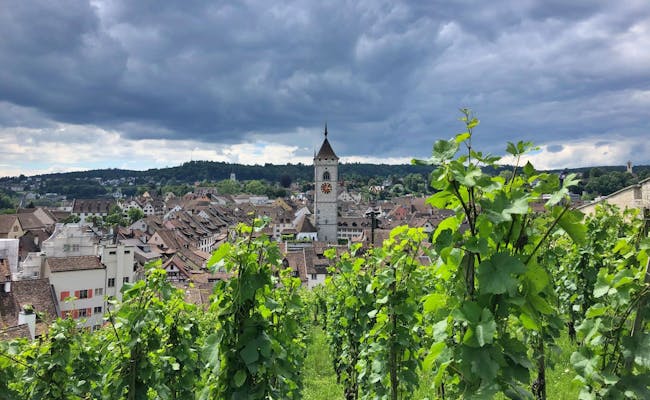 Ausblick auf Schaffhausen (Foto: Seraina Zellweger)
Ausblick auf Schaffhausen (Foto: Seraina Zellweger)After breakfast and maybe spending some more time strolling through Schaffhausen, hop on the train and visit the picture-perfect old town of Stein am Rhein. This little town is where Lake Constance ends and the River Rhine begins.
Small yet incredibly charming, Stein am Rhein is the ideal place to spend some time admiring those beautifully painted houses. Once you’ve seen enough, embark on a journey up the River Rhine and back to Schaffhausen. This boat trip takes roughly two hours and is said to be one of the prettiest in Switzerland.
Back in Schaffhausen, grab your luggage and move on to Kreuzlingen by Lake Constance.
Fairly big Lake Constance is 63 kilometres (39 miles) long, up to 14 kilometres (8.7 miles) wide and shares its shores with Germany, Austria and Switzerland. This tri-national area offers a considerable amount of sights and activities for you to discover.
For one, there’s the picturesque town of Constance in Germany, which is within walking distance from Kreuzlingen. Most Swiss go there for its cheap shopping, but Constance has more to offer than low-priced stores.
With its charming old town, a wide array of cafés, restaurants, ice cream places and peaceful spots to hang out by the lake, Constance certainly manages to attract visitors throughout the warmer months. If you’re into fish and other creatures that live and dwell under water, the Sea Life is always a potential bad weather option.
Of course, you don’t need to leave the country to enjoy Lake Constance to its fullest. Visit one of the many beaches, go for a swim, catch a passenger ship, rent a stand up paddleboard, grab a bike and follow the trails or go for a walk along the lakeshore.
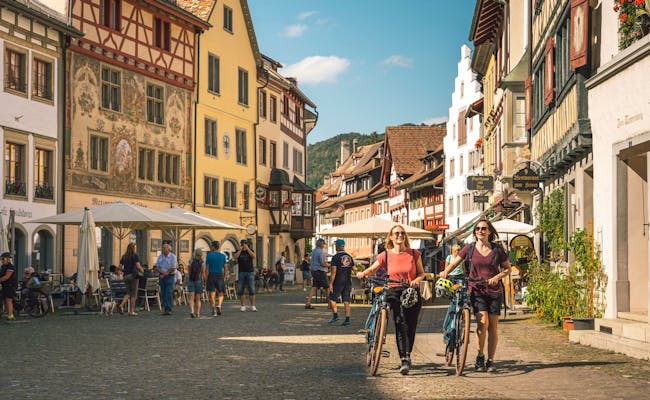 Gasse in Stein am Rhein (Foto: Schweiz Tourismus Christian Meixner)
Gasse in Stein am Rhein (Foto: Schweiz Tourismus Christian Meixner) Hafen von Rorschach (Foto: Mattias Nutt Photography)
Hafen von Rorschach (Foto: Mattias Nutt Photography)Spend as much time in the Lake Constance area today as you please. The train ride to Rapperswil, your next destination, takes two hours so you’ve got pretty much all day out here.
The Canton of Thurgau, which makes up most of the Swiss part along Lake Constance, is famous for its apple trees. One of the walks we recommend in this area is the Altnauer apple trail. It’s particularly idyllic when the trees bloom in April and May or then again during harvest time in autumn. The trail is divided into three separate trails, which all contain informative signs addressing different topics. Combine all three trails and you’ll know everything there is to know about apples. Options to buy and taste a selection of apple products are plentiful along the way, too.
Additional places of interest by Lake Constance are the towns of Romanshorn, Rorschach and of course Kreuzlingen, where you spent last night.
Once you’re ready to leave and continue your journey, catch the train to Rapperswil. Travel to St. Gallen and get on the Voralpen-Express, a scenic train connecting St. Gallen with Lucerne. Get off halfway in Rapperswil, where you’ll be spending the night. We’re assuming you won’t have too much left of the day after your arrival. Just relax in this pretty town by the shores of Lake Zurich. Head up to the castle, spend some time with the deer in the castle garden, go for a swim in Lake Zurich and walk along the idyllic esplanade.
 Blühender Altnauer Apfelweg (Foto: MySwitzerland)
Blühender Altnauer Apfelweg (Foto: MySwitzerland) Hafen von Rapperswil (Foto: Seraina Zellweger)
Hafen von Rapperswil (Foto: Seraina Zellweger)If you’re looking for an easy walk after breakfast, follow the wooden footbridge and the connecting walkway across the lake to Pfäffikon. In doing so, you’ll be completing three kilometres (1.8 miles) of the Camino de Santiago trail, a pilgrim route leading from different places across Europe to Santiago de Compostela in Spain. In case you’d rather not walk both ways, frequently leaving trains will take you back across the dam from Pfäffikon to where you started.
Back in Rapperswil, grab your luggage and embark on a short train ride to Zurich. Or, instead of travelling by train, you also have the option to hop on the passenger ship. The ride takes roughly two hours and might be a great way to take some speed out of your travels.
You can either head out to explore Zurich on your own, borrow a free bike with «Züri rollt» or join a guided city tour. In the afternoon, catch the train back to Geneva. Depending on what your plans in Geneva are tonight, you have a few hours to explore before terminating your trip.
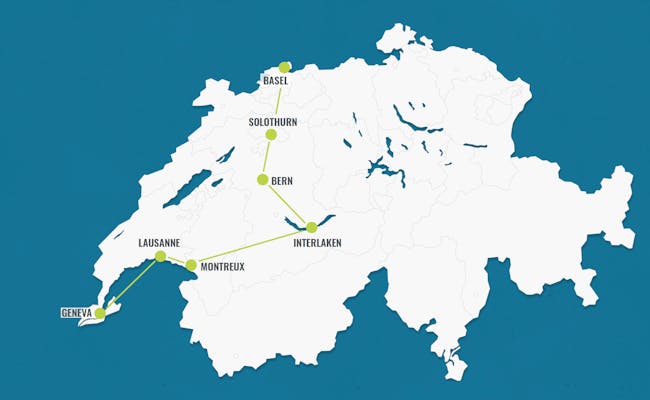 Reiseroute 10: Genf - Interlaken - Bern - Basel
Reiseroute 10: Genf - Interlaken - Bern - BaselHighlights on this itinerary:
In the morning, explore Geneva on your own, borrow a free bike with «Genève Roule» or join a free walking tour. After the tour, buy some take-away lunch and have it on the train to Lausanne.
This picturesque old town was built on three hills and is surrounded by countless vineyards. It’s home to the International Olympic Committee, as well as Switzerland’s only metro. Move on to Montreux whenever you’re ready, drop your bags at your accommodation and spend the rest of the day exploring Montreux.
In case you’re interested in castles, don’t miss out on visiting the famous Chillon Castle. To get there, either follow the Promenade by foot, catch a bus or take one of the regularly departing passenger ships.
Even if you’re not keen on going into the castle, we still recommend heading out there and spending some time by the lake. It’s a great place to hang out and take a bunch of jealousy-inducing pictures.
Alternatively, head over to Lavaux. Only a short train ride west of Montreux, you’ll find the famous Lavaux vineyards, a UNESCO World Heritage site. To fully experience the gorgeous views, get off in Cully or Epesses and follow the signposted footpath through the vineyards.
 Stadtbild von Lausanne (Foto: Régis Colombo)
Stadtbild von Lausanne (Foto: Régis Colombo)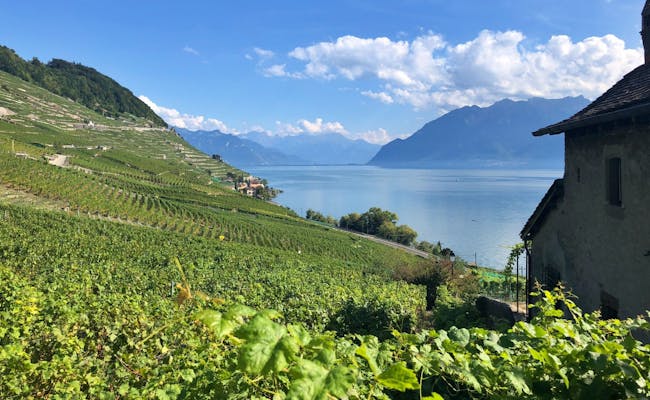 Weinberge von Lavaux (Foto: Seraina Zellweger)
Weinberge von Lavaux (Foto: Seraina Zellweger)You’re in for plenty of scenic treats today. Spend a few more hours in and around Montreux in the morning before moving on. Leave the Lake Geneva region and start your climb up into the Alps on the Golden Pass Line. After a couple of tunnels, you’ll arrive in the Bernese Oberland, our favourite part of the whole train journey.
This region is an absolute dream for mountain-lovers and pretty much sums up what Switzerland is about. Lakes, mountains, lush meadows with grazing cows, glaciers, tons of hiking trails, wonderful landscapes and cute little villages are abundant in this area.
Even if you don’t have enough time to get off along the way, the ride through this picturesque area is something you probably won’t forget anytime soon. After leaving the Bernese Oberland and coming down the hills, you’ll arrive in Zweisimmen, where you’ll need to transfer to another train.
The last leg of the journey takes you past Spiez and Lake Thun before you finally arrive in Interlaken. Spend whatever you have left of the day exploring this popular town and get ready for a couple of days in this adrenaline and scenery-packed destination.
 Sonnenuntergang in Montreux (Foto: Montreux-Vevey Tourism Maude Rion)
Sonnenuntergang in Montreux (Foto: Montreux-Vevey Tourism Maude Rion)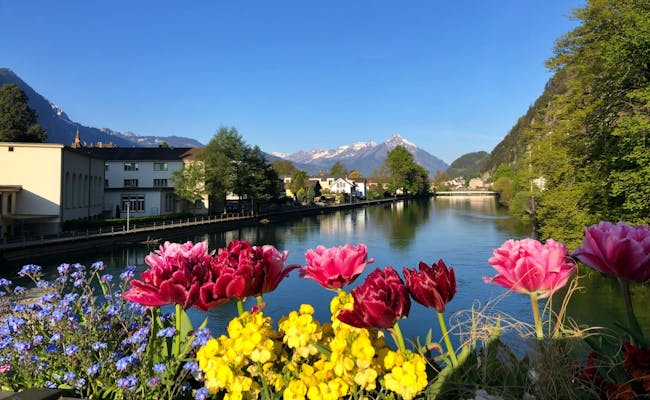 Blumen in Interlaken (Foto: Mathias Graf)
Blumen in Interlaken (Foto: Mathias Graf)You’ve got more activities to choose from these next three days than you can wrap your head around. It all depends on your budget, but in an adrenaline-packed place like Interlaken, the sky’s the limit.
If even that...
Skydiving, paragliding, canyoning and jet boating are all popular activities that will get your adrenaline flowing.
Another option is to embark on a passenger ship cruise on either Lake Thun or Lake Brienz. Both rides come with incredible views that will make you wish you’d never have to leave.
If you’re looking for a stopover on one of the cruises, get off at either Giessbach (Lake Brienz), the Saint Beatus Caves or Spiez (Lake Thun).
The Jungfrau region around Interlaken is also an excellent playground for hikers. The amount of trails is nearly endless and whatever your fitness level and ambitions, you’ll find something to your taste.
Of course, the No. 1 destination everybody wants to see out here is the famous Jungfraujoch – aka Top of Europe. If you’re after a slightly more budget-friendly experience, we suggest looking into visiting Mount Schilthorn, Schynige Platte, Grindelwald First or Männlichen instead. The rides up to these mountains and the views from the top won’t disappoint you.
Other places of interest in and around Interlaken are: the open-air museum Ballenberg, the chocolate workshops at Funky Chocolate Club, the two mountain lakes Blausee or Oeschinensee or the Aare Gorge.
And let’s not forget those charming towns and villages like Brienz, Spiez, Thun, Lauterbrunnen or Grindelwald.
We could go on forever here but we guess this would only make you hate that you don’t have all week here.
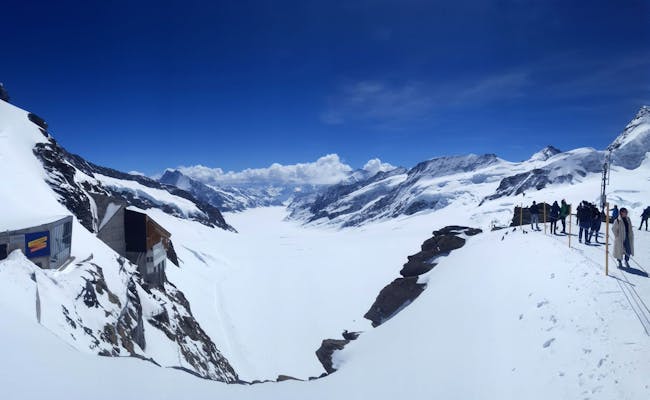 Ausblick vom Jungfraujoch im Winter (Foto: Dennis Josek)
Ausblick vom Jungfraujoch im Winter (Foto: Dennis Josek) Fahrt mit der Jungfraubahn (Foto: Jungfraubahnen)
Fahrt mit der Jungfraubahn (Foto: Jungfraubahnen)We’re assuming you’ve had enough time to tick off all your must-dos in Interlaken these past three days and are ready to see Bern now. In this charming UNESCO listed city, you’ve got plenty of activities to choose from as well.
Join a guided city tour or explore Bern on your own. Take a stroll through the old town, head to the bear park, check out the Bundeshaus (House of Parliament) and walk back to Rosengarten for the views.
You can also visit Gurten – Bern’s backyard mountain – see some animals at Dählhölzli wildlife park or visit the botanical garden. Alternatively, catch the elevator at the train station to hang out at Grosse Schanze or go for a swim either in the River Aare or at Weyermannshaus.
You should definitely find enough things to keep you busy for a while. Whenever you feel like you’re ready to leave Switzerland’s capital, hop on the train for a short ride to Solothurn, commonly known as Switzerland’s most beautiful baroque city.
You might not have much time to discover Solothurn tonight. So treat yourself to a few scoops of ice cream at Vitaminstation – one of the ice cream places ever – and have it while sitting on the stone wall along the River Aare.
You’ll fit right in with the locals in doing so.
Seraina’s Tip: My two absolute favourite places for food in Solothurn are Pittaria and Vitaminstation. Anyone that likes a good falafel or hummus is going to love Pittaria. And Vitaminstation makes some of the best ice cream I’ve ever tasted in Switzerland.
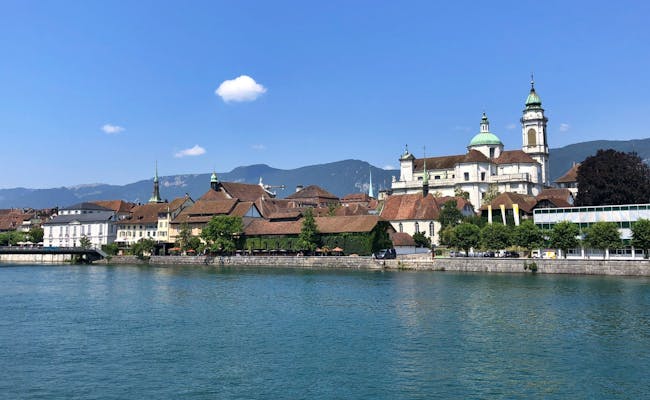 Kirche am Fluss in Solothurn (Foto: Seraina Zellweger)
Kirche am Fluss in Solothurn (Foto: Seraina Zellweger) Erfrischung von der Vitaminstation (Foto: Seraina Zellweger)
Erfrischung von der Vitaminstation (Foto: Seraina Zellweger)Although Solothurn is by no means a big city, there’s still plenty to see and do in the area. One activity we particularly recommend is going on a hike in the Jura mountains. This high plateau is a wonderful area to visit all year round.
One option to reach the top with its countless walking trails is by cable car from Oberdorf to Weissenstein. Feel free to walk as long and as far as you like before hiking back down or catching the cable car to Oberdorf.
A very popular hike is the round trip from Solothurn via Balmberg and Weissenstein. Catch the Postauto in Solothurn, get off at Balmberg, walk along the crest to Weissenstein and head back down to Oberdorf by cable car. From Oberdorf, the train will take you back to Solothurn.
This is an easy walk and takes you into the Jura without too much effort. During your hike, you’ll also enjoy the view over the Alps, including Eiger, Mönch and Jungfrau.
Another place you can visit is Verena Gorge. You can walk along the creek through the forest in the gorge until you reach the little hermitage at the end. The walk takes roughly 45 minutes return and is super peaceful.
Alternatively, hop on the passenger ship to Biel. How long you stay on it really depends on your preferences. You can go all the way to Biel – which takes around three hours – or get off anywhere along the way and catch the train back to Solothurn.
One of the highlights on this tour will be Switzerland’s largest stork station in Altreu, which you’ll pass about 45 minutes into the journey. In 1950, when storks were nearly extinct in Switzerland, Max Bloesch started his reintroduction project to save our storks. Thanks to him, around 40 breeding pairs can be seen soaring through the air, strutting across the fields and clattering on the rooftops around Altreu these days.
Only in spring and summer, though. They travel to warmer territories in autumn until winter is over.
If you continue your journey onward to Biel, the views of the Jura mountains and the Swiss Central Plateau will accompany you all the way. After passing through a watergate, you’ll arrive at the port in Biel, which is only a short walk from the train station.
From there, heading back to Solothurn will take 15 minutes by train. Back in Solothurn, grab your bags and hop on another train that will take you to Basel within just an hour.
Basel is a vibrant city right on the German and French border. It offers several walking tours at various times throughout the week. Pick a tour or just head out into the city on your own.
Stop by the Pfalz – the perfect viewing platform to snap some postcard-quality photos – walk along the River Rhine to watch the big cargo ships enter and leave the harbour, pass by the Cathedral or geek out in one of the many museums.
During the warmer summer months, an activity you might enjoy is joining the locals for a swim in the River Rhine. Before hopping into the water and letting the current take them downstream, they usually pack their clothes into a so-called Wickelfisch. This dry-bag comes in the shape of a fish and is iconic to Basel.
Alternatively, you can always hop across the border and visit Weil am Rhein in Germany or St. Louis in France. Technically, you could even visit three countries in one day: Switzerland, Germany and France. That’s completely doable in Basel and might be something you don’t get to experience every day. Especially if you’re from a country that requires you to get on a plane to cross the nearest border within a reasonable amount of time.
Whenever you’re ready to leave Basel, head back to Geneva and spend the rest of the day exploring Switzerland’s second largest city.
 Rhein Brücke in Basel (Foto: Schweiz Tourismus Jan Geerk)
Rhein Brücke in Basel (Foto: Schweiz Tourismus Jan Geerk)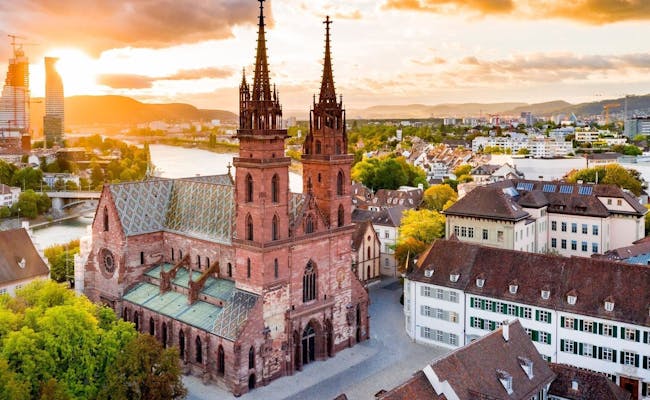 Münsterplatz in Basel (Foto: Basel Tourismus)
Münsterplatz in Basel (Foto: Basel Tourismus)And this concludes our collection of eight-day itineraries for Switzerland. We hope you’ve been able to find the Switzerland itinerary to your taste. Have fun planning your trip.